History
of the parish & its principal church
- This
page includes many links to external sites giving more detailed information, shown in blue. [See this article, from East End Life.]
- Others
are to additional pages on this site, including texts
of original
documents, shown in green; they are also shown on the sitemap.
- Click on any image to enlarge.


 Note
that down
the years many street names have changed. The first major renaming
scheme was started in 1857 by
the Metropolitan Board of Works, encouraged by the General Post
Office, after the MBW was established by the Metropolis Management Act
of 1855 (postal districts were introduced in the following year).
Another took place in the 1890's, after the London County Council was
formed, and the next
big scheme occurred between 1929-45. Streets were often re-named after
local 'worthies', whose stories are told on the various history pages.
Click right for street lists of 1913, 1919 and 1923. See here for details of a few sites on the western edge which now fall within the City of London, rather than Tower Hamlets.
Note
that down
the years many street names have changed. The first major renaming
scheme was started in 1857 by
the Metropolitan Board of Works, encouraged by the General Post
Office, after the MBW was established by the Metropolis Management Act
of 1855 (postal districts were introduced in the following year).
Another took place in the 1890's, after the London County Council was
formed, and the next
big scheme occurred between 1929-45. Streets were often re-named after
local 'worthies', whose stories are told on the various history pages.
Click right for street lists of 1913, 1919 and 1923. See here for details of a few sites on the western edge which now fall within the City of London, rather than Tower Hamlets.
St George-in-the-East was a civil registration
district (as well as an ecclesiastical parish) 'in the county of
Middlesex' from 1837 to 1889, and in the 'county of London' from 1889
to 1925, when it was designated as 'Stepney'.
THE
EIGHTEENTH CENTURY
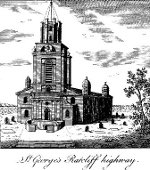 After
Queen Anne came to the throne (1702-14), under the terms of the Acts of
Settlement designed to ensure the Protestant succession, and the Tories
took power after 22 years of Whig rule, a New
Churches in London &
Westminster Act
of 1710/1711 was passed, establishing a Commission to build fifty new
churches in populous districts. [See here for details of a 2011 Walk which marked its 300th anniversary.] The agenda was as much political as
pious: imposing edifices towering
over the homes of the working classes as a sign of the national religion -
especially needed, it was believed, in the East End where immigration
was taking hold and there were many dissenting conventicles. (This is
why episcopal mitres feature in the decoration of the apse, and no doubt why the dedication to St George was chosen.) They were
to be funded from a tax on coal and culm (a form of anthracite) - in theory, an infinite budget, but
only twelve (including St George-in-the-East) were ever completed. All
ran way over budget, and the scheme came to an end. There is much more
about
the architectural rationale, and Nicholas Hawksmoor the architect of
six of these churches, on
the Church & Churchyard page.
After
Queen Anne came to the throne (1702-14), under the terms of the Acts of
Settlement designed to ensure the Protestant succession, and the Tories
took power after 22 years of Whig rule, a New
Churches in London &
Westminster Act
of 1710/1711 was passed, establishing a Commission to build fifty new
churches in populous districts. [See here for details of a 2011 Walk which marked its 300th anniversary.] The agenda was as much political as
pious: imposing edifices towering
over the homes of the working classes as a sign of the national religion -
especially needed, it was believed, in the East End where immigration
was taking hold and there were many dissenting conventicles. (This is
why episcopal mitres feature in the decoration of the apse, and no doubt why the dedication to St George was chosen.) They were
to be funded from a tax on coal and culm (a form of anthracite) - in theory, an infinite budget, but
only twelve (including St George-in-the-East) were ever completed. All
ran way over budget, and the scheme came to an end. There is much more
about
the architectural rationale, and Nicholas Hawksmoor the architect of
six of these churches, on
the Church & Churchyard page.
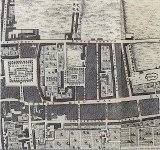 When
the church was consecrated on 19 July 1729, parts of 'Wapping-Stepney' were still
semi-rural, with open fields, but the area was beginning to develop. Right is
Roque's map of 1746.
Merchants who were building houses nearby, or came from further afield,
attended church in their
carriages (in 1739 only seven of the 2484 inhabitants of London that
'kept
coaches' lived in the parish), and access into the church was socially
segregated. The
local trades were ship-rigging and rope-making, of which
names like Cable Street and Ropewalk Gardens are a reminder - Cable
Street was once the length of the standard cable measure, 600 feet
[180m], with a ropewalk directly to the north of the church. From the
middle of the century hovels appeared in the marshlands behind
Pennington Street, which soon became wholly built over. By 1780 there
were 300 houses; by 1800, an average of 500-600 baptisms (rising
to over 1,000 two decades later, before daughter churches were built),
and
400-600
burials a year. The parish in those days extended down to the river:
the old parish of St John Wapping only covered a small area. In 1766 a
committee drawn from both parishes met to determine a procedure for
settling any disputes over 'bounds and boundaries'.
When
the church was consecrated on 19 July 1729, parts of 'Wapping-Stepney' were still
semi-rural, with open fields, but the area was beginning to develop. Right is
Roque's map of 1746.
Merchants who were building houses nearby, or came from further afield,
attended church in their
carriages (in 1739 only seven of the 2484 inhabitants of London that
'kept
coaches' lived in the parish), and access into the church was socially
segregated. The
local trades were ship-rigging and rope-making, of which
names like Cable Street and Ropewalk Gardens are a reminder - Cable
Street was once the length of the standard cable measure, 600 feet
[180m], with a ropewalk directly to the north of the church. From the
middle of the century hovels appeared in the marshlands behind
Pennington Street, which soon became wholly built over. By 1780 there
were 300 houses; by 1800, an average of 500-600 baptisms (rising
to over 1,000 two decades later, before daughter churches were built),
and
400-600
burials a year. The parish in those days extended down to the river:
the old parish of St John Wapping only covered a small area. In 1766 a
committee drawn from both parishes met to determine a procedure for
settling any disputes over 'bounds and boundaries'.
The
original organ, of 3 manuals with 25 speaking stops, was installed in
1733 by Richard Bridge (d.1758) of Clerkenwell. A contemporary commentator,
whose identity and credentials are uncertain, described it as a very plain instrument.
(Bridge's most famous organ - currently under restoration - was for
another Hawksmoor church, Christ Church Spitalfields, where the
Huguenot Peter Prelleur was organist - as well as writing theatre music.) The first organist of St George-in-the-East, appointed in
1738, was John
James,
formerly of St Olave Southwark and possibly a trumpeter in the King's
Musick. He was a star performer with a
reputation for improvisation - it's said that Handel, Geminiani,
Roseingrave, Greene, Pepusch and Boyce all heard him play. His
voluntaries were taken up by other organists (one of them was taken for
Handel's work) - they were said to be popular with ‘every deputy
organist in London’ - and many survive because they combine inventive
harmonic sequences with a good grasp of fugal technique. But he had his wilder side,
enjoying bull-baiting and dog fights, and according to Sir John Hawkins he indulged an inclination to spiritous liquors of
the coarsest kind, though Hawkins admitted that he was distinguished by the singularity of his style, which was learned and sublime. He died in 1745. (See here for the later history of Bridge's organ.)
On Sunday
1 October 1738 John Wesley preached at the morning and afternoon
services at the church - details here.The Gentleman's Magazine (vol 37) reported that on 4 March 1767 a private papist mass-house, which was kept at the back part of the house of a tradesman near Salt-petre bank [now Dock Street] was
suppressed: about twenty mean-dressed people, with the priest, were
assembled; but on the alarm of peace officers, made their escape at a
back door - see here for more about the history of the Roman Catholic presence in the parish.
Charity schools were established in the parish - see here for an account of Raine's Foundation institutions from 1719 onwards, and here for the school founded in 1781 by the Middlesex Society, and also for an overview of all the subsequent educational foundations. As
with some other new East London parishes of this period, St
George-in-the-East, though within the diocese of London, was exempt
from the jurisdiction of any archdeacon, and this anomaly remained into
the 19th century. The Vestry combined ecclesiastical and local
government responsibilities, and was 'general' (as opposed to 'select',
as elsewhere), open to all who paid 2s. or more per month for poor relief. Robert Seymour's 1835 Survey of the Cities of London & Westminster
- a part-published update of the work of the Elizabethan chronicler
John Stow - gives details of the officers it continued to appoint: 2
Churchwardens and 4 Overseers (the senior 'parish officers') and - from the lower
and middling ranks of society - 1 Constable, 13 Headboroughs (subordinates to the Constable, responsible for law enforcement), 4
Scavengers (responsible for keeping the streets clean), and 2 Surveyors
of the Highway ('peace officers'). As explained here, men were sometimes elected as
councilmen and aldermen who did not wish to serve for business or
religious reasons, in which case they could pay a fine to be exempted. The
parish was divided into two divisions, the upper and lower town
(Seymour lists the streets in each). Edward Scott was elected
Scavenger for the upper division of the parish in 1732, and Thomas
Saunders of the lower division in 1748. Left is
a challenge of 1754 on the regularity of the appointment of the
overseers of the poor, and on their assessments (claiming that the
well-to-do have been undercharged and the less affluent overcharged) -
a transcript can be read here. The first parish clerk was Samuel Bright, formerly a barber and periwig-maker: the Vestry determined that this should be a full-time post. His successor was Thomas Harmer Lacon (buried in a vault in the crypt in 1821, aged 65). Both of them frequently signed as witnesses in the marriage registers. See here for an account of the dismissal of Joseph Mee as grave-digger and bell-ringer in 1766. (Seymour also noted that 'Prayers are held on Wednesdays, Fridays, and Holidays [sic] about 11 o'clock, no Organ [but see above], one Bell'.)
As
with some other new East London parishes of this period, St
George-in-the-East, though within the diocese of London, was exempt
from the jurisdiction of any archdeacon, and this anomaly remained into
the 19th century. The Vestry combined ecclesiastical and local
government responsibilities, and was 'general' (as opposed to 'select',
as elsewhere), open to all who paid 2s. or more per month for poor relief. Robert Seymour's 1835 Survey of the Cities of London & Westminster
- a part-published update of the work of the Elizabethan chronicler
John Stow - gives details of the officers it continued to appoint: 2
Churchwardens and 4 Overseers (the senior 'parish officers') and - from the lower
and middling ranks of society - 1 Constable, 13 Headboroughs (subordinates to the Constable, responsible for law enforcement), 4
Scavengers (responsible for keeping the streets clean), and 2 Surveyors
of the Highway ('peace officers'). As explained here, men were sometimes elected as
councilmen and aldermen who did not wish to serve for business or
religious reasons, in which case they could pay a fine to be exempted. The
parish was divided into two divisions, the upper and lower town
(Seymour lists the streets in each). Edward Scott was elected
Scavenger for the upper division of the parish in 1732, and Thomas
Saunders of the lower division in 1748. Left is
a challenge of 1754 on the regularity of the appointment of the
overseers of the poor, and on their assessments (claiming that the
well-to-do have been undercharged and the less affluent overcharged) -
a transcript can be read here. The first parish clerk was Samuel Bright, formerly a barber and periwig-maker: the Vestry determined that this should be a full-time post. His successor was Thomas Harmer Lacon (buried in a vault in the crypt in 1821, aged 65). Both of them frequently signed as witnesses in the marriage registers. See here for an account of the dismissal of Joseph Mee as grave-digger and bell-ringer in 1766. (Seymour also noted that 'Prayers are held on Wednesdays, Fridays, and Holidays [sic] about 11 o'clock, no Organ [but see above], one Bell'.)
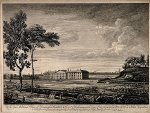 There were two
early medical charities
(unconnected with the church, though see here for an example of the involvement of a churchwarden with these two institutions, and with the emerging London Hospital - right in 1740s, with St George-in-the-East in the background:
There were two
early medical charities
(unconnected with the church, though see here for an example of the involvement of a churchwarden with these two institutions, and with the emerging London Hospital - right in 1740s, with St George-in-the-East in the background:
- the Eastern
Dispensary
(1782) - see here for details
- the Universal
Medical Institution
(1792)
on Old Gravel Lane, with 450 subscribers (president the Earl of Fife),
providing free advice,
medicine, cold, warm and vapour baths, inoculation and 'relief in cases
of suspended
animation' to all who attended at the 'proper hours' (viz. 9am-1pm and
3pm-5pm). Admission was on the recommendation of a Governor, and
out-patient visits were made within the limits of the Tower Hamlets.
By 1809 17,134 patients had been treated, of whom 14,978 were cured,
plus 841 midwifery cases; 460 were 'relieved' and 646 had died. 3,009 persons also had been inocutated with the cow-pox (see here for more on how vaccination replaced this practice of variolation).
Another
survival from this period - originally in the parish of St Mary Matfelon, then St Mark Whitechapel and
then St Paul Dock Street, and now part of this parish - is the Gunmakers' Company Proof House at
46-50 Commercial Road, of which there are more details and pictures here.
In the last decade of the century revolution was in
the air, because of events in France and rising taxation (the war with
France required an extra £2m) - more details here.
At St George's 47 special constables were sworn in to assist in
quelling any riots; the Vestry offered bounties to those who
volunteered to take the place of parishioners called up to serve in the
navy; and in 1795 a local branch of John Reeves' 'Church and King
militia', the Association for the Protection of Property against Republicans and Levellers, was formed, to mobilise against those who supported monstrous and nonsensical doctrines of equality. This
was followed by an armed association to protect life and property, for
which twenty men volunteered, providing their own uniform and arms. 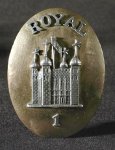 A 1796 Act of Parliament required annual training, under the direction of the Constable of the Tower, of a regiment of the Tower Hamlets Militia (whose origins lay in the pre-Civil War 'Trayned Bandes'
to protect the Tower, taking the name of Tower Hamlets in 1605). The
Vestry objected (unsuccessfully) to the number called up - it was done
by ballot, with a quota from each of the Hamlets - complaining that
many inhabitants were ineligible, being seafaring persons, free watermen, labouring men with infirmities, and
undersized (particularly in the weaving manufactories), foreigners and
other exempted persons.
A further Act of 1813 extended their service liability to all parts of
the kingdom, and removed a previous anomaly which expressly excluded TH
militiamen's families from financial relief. The following year 25 men
served in the Waterloo campaign with the 3/14th Regiment of Foot ('A very Pretty Little Battalion').The First Regiment had its own March and Quickstep, by William Liquorish (a relative of Thomas Liquorish,
who had served with the Militia prior to serving as churchwarden),
published in 1796 in full score for regimental band and in piano
adaptation. [Shoulder belt plate from this period right - these were abolished in 1855.] The Militia office was in Wellclose Square.
A 1796 Act of Parliament required annual training, under the direction of the Constable of the Tower, of a regiment of the Tower Hamlets Militia (whose origins lay in the pre-Civil War 'Trayned Bandes'
to protect the Tower, taking the name of Tower Hamlets in 1605). The
Vestry objected (unsuccessfully) to the number called up - it was done
by ballot, with a quota from each of the Hamlets - complaining that
many inhabitants were ineligible, being seafaring persons, free watermen, labouring men with infirmities, and
undersized (particularly in the weaving manufactories), foreigners and
other exempted persons.
A further Act of 1813 extended their service liability to all parts of
the kingdom, and removed a previous anomaly which expressly excluded TH
militiamen's families from financial relief. The following year 25 men
served in the Waterloo campaign with the 3/14th Regiment of Foot ('A very Pretty Little Battalion').The First Regiment had its own March and Quickstep, by William Liquorish (a relative of Thomas Liquorish,
who had served with the Militia prior to serving as churchwarden),
published in 1796 in full score for regimental band and in piano
adaptation. [Shoulder belt plate from this period right - these were abolished in 1855.] The Militia office was in Wellclose Square.
Here are details of the Rectors and Lecturers of this period; here are details of many of the 18th century churchwardens; and here
is a 1795 account of the church, churchyard and other places of
worship in the parish. A fascinating article by Diana Markarill appeared
in The Ephemerist, no.148
(Spring 2010), based on the churchwardens' accounts for the late 18th
and early 19th centuries, for work on the bells and organ, the payment
of women for pew-opening duties [in 1729 the Vestry had agreed to have six and no more;
22 applied - tips made it a post worth having - and four women and two
men were appointed] and washing and mending linen, and for
various entertainments. Horwood's map of London (1792-99), updating
Roque, provides excellent detail. Developing areas not in the original
parish, but now within its boundaries though parish mergers, include Goodman's Fields, Rosemary Lane [Royal Mint Street] and East Smithfield (including the site of the Royal Mint built in 1809).
Gower's Walk Free School
was founded in 1808 - its remarkable story is told here.
The Royal Mint in East
Smithfield was rebuilt in 1809 and 1842. The nearby Shovel public house was the site of
an
early example of the racial tensions that were to beset the area: it
was reported that on 29 June 1787 local
constables were beaten and turned out of the pub by over 40 black
drinkers.
1811
saw the notorious Ratcliff
Highway murders, described in detail here
and here.
The events
highlighted the lack of any proper policing and detective service, and
this page describes the establishment of the Metropolitan Police in
1829, and the evolution of professionally-staffed magistrates' courts. Ten
years later, as
explained here, St
George-in-the-East Vestry was complaining about the expense of the
'Met', and
the fact that it had done nothing to reduce criminality in the area -
indeed, they believed it had made matters worse, and reduced the sense
of local
control; also, they said that the the officers were too military in appearance - see here to judge if that was true.
In
the years after the end of the Napoleonic Wars in 1815, the Vestry protested
against high wheat prices at home, heavy import duties on imported
corn, and restrictions on foreign trade - which was to become a
recurring theme: in 1833 they took up the cause of the local sugar
trade
which was beginning to struggle. There were ongoing issues in relation
to the Docks - rates, and the impact on the coal trade. They were
exercised by the 1832
Reform Act and Poor Law
issues. And although the church bore the name of the Hanoverian
monarchs, they shared the national mood of disapproval of George IV, in
particular his treatment of his wife Queen Caroline, writing to her in
fulsome terms to declare their support - full text and more details here.
The
height of the parish's
prosperity was in the 1810-20's: see here
for some details of some of the residents of Cannon Street Road, and here
for Wellclose Square (at that time, outwith the parish). Here
is a description of the elaborate funeral
procession in 1824 for the
vicar of Tottenham, who was buried here in a family vault near the west
door. It contrasts
sharply with the very basic arrangements for most parishioners'
funerals!
The
early 19th century saw the rise of small local 'friendly societies'. Some began as pub-based drinking clubs that organised mutual welfare by
'passing the hat', becoming more organised through formal
subscriptions; they were later linked to the temperance movement, and
were controlled by legislation (they were the precursors of credit
unions). Two that met at the George Tavern in St George's Street in the
1830s were the Eastern Burial Society
and the True and Happy Friends
Benefit Society. Others had their origin in self-help associations within the Huguenot and Jewish communities. The
first Jewish friendly society, dating from 1812, was The Tent of Righteousness (which a century later invested £500 in the 4% Industrial Dwellings Company). By
the turn of the 20th century 15,000 Jews were actively involved in the
movement (two small local examples were the Podembitzer Friendly Sick Society at 135 Cannon Street Road and the Plotzkar Relief & Sick Benefit Society at the Kinder Arms, Little Turner [Rampart] Street); the Grand Order of Israel and Shield of David Friendly
Society is the last survivor, with four lodges still operating, mainly as
social clubs. See here for a later Rector's desire (1875) that well-run penny banks should replace the plethora of local institutions.

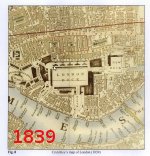
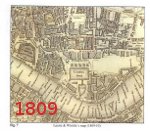
The Docks
Poverty and
deprivation was soon to take hold.
Rapid
social change was triggered by the expansion of
shipping, with its associated trades: see London and St Katharine's Docks (at the time, mainly in this parish but the area is now part of our daughter church St Peter London Docks). See here
for details of the legal battle between the Vestry and the Docks over
rates. Laurie and Whittle's map of 1809, and Crutchley's of 1839 [right] show the impact. Here is an 1810 list of authorised pilots, including many living in this parish, and here is the Watermen and Lightermen's Company 'Bum Book' listing boat owners and their details from 1839-59.
London Docks were
begun
in 1802 (Lord Sidmouth, First Lord of the Treasury,
laying the foundation stone on 26 June of that year, with 'genteel persons of both sexes' in attendance), and almost
immediately
enlarged; the adjacent St Katharine's Dock was opened in 1828. Vessels had to use the London Docks if
they
were bring tobacco or rice not of East or West India growth, or wine or
spirits; other cargoes could unload elsewhere. Specialist warehouses (for example, wool and tobacco),
and other trades, including the smelly sugar refining that
employed over 1,000 German workers, sprang up. The docks
brought incomers
from many other nations -
Greeks, Malays, Dutch, Scandinavians, Portuguese, Spanish and
French. Thomas de Quincey wrote in 1810 Lascars, Chinese, Moors, Negroes were met at every step. Dock
workers were poorly paid (5d. an hour) and poorly housed. An 1848
survey of 1651 heads of families living in the civil parish of St
George-in-the-East showed that dock work had become the majority
occupation, and two thirds of families existed on less than 25s. a
week, with only 17% earning over 30s. Boarding
houses, taverns and saloons brought crime. When Brian King became
Rector in 1842, there were said to be
154 brothels in the parish. Railways also began to criss-cross the
area.
Although the churches' main provision for seafarers' needs was centred in the
Dock Street area - details here
- there were two institutions, both in Cannon Street
Road: the Sailors' Rest Asylum (taken over from 'Bo'sun' Smith's
non-denominational mission in 1832) and a Sailors' Orphan Girls
Episcopal School and Asylum, set up in 1829. Both of these, and other provisions for the orphans of seamen, are
described here.
Civil administration and relief; public health
Civil registration
of births, marriages and deaths was introduced nationally from 1 July
1837, and many churches saw a major blip in baptisms in the preceding
days, because parents wanted to avoid the new system, and had got the
false impression that baptisms would in future cost 7s 6d, because the
Registrar would need to be present. (At Manchester Collegiate Church,
now the Cathedral, and in those days the sole parish for the city,
there were a staggering 7,285 baptisms that year.) At St
George-in-the-East there were 125 baptisms on 25 June, 149 on 28 June
and 163 on 30 June (compared with 105 for all the preceding weeks) -
see here
for more details of how this was handled. (A 1s or 1s 6d fee for
baptism - or at least, for registration and the clerk's attendance -
was common at the time despite being counter to church teaching that
the
sacraments should be available without charge; fees were made illegal
by the Baptism
Fees Abolition Act 1872.) See here for statistics, and also comments on non-Anglican marriages.
The local Registrars' statistics were used for a wide-ranging 1843
report on death rates, and funeral practice, across London. Figures for
1839 showed that the average age of death was the 24th lowest, out of
32, and that life expectancy for tradesmen was 13 years, and for
artisans 16 years, below average. John Verrall, the Registrar for the
St John's District (mainly Wapping), and also parish clerk of St
George's, commented on the causes of this: overcrowding, the ruinous
state of many houses, lack of drainage and ventilation, poor habits of
cleanliness, the number of lay-stalls [dungheaps], in which filth of all kinds is accumulated, and the number of pigs kept in the neighbourhood. See here for more details.
The
1831 census (and clerical directories for this period) gave the
population as 38,505, and poor relief
expenditure
for 1833-35 was £17,706 or 9s.2d. per ratepayer. (In 1739 the figure had been £1,046 10s 4d.) In 1836,
the parish was constituted as a Poor Law parish
under the 1834 Poor
Law Amendment Act,
administered by 18 elected Guardians. Several of these had also served
as churchwardens of the parish (a higher proportion than in other districts) - for example, William Stutfield in 1843, and Thomas Liqorish in 1844. They took over responsibility for the parish workhouse in Wapping, and authorised £2,000
for
its extension. By 1847 the population was 47,362 but expenditure was
slightly down - £16,474. In
1851 they built an industrial school at Plashet, and also operated a
'casual ward' for vagrants in Raymond Street, off Green Bank, Wapping.
By 1861 the population was 48,891. An infirmary was added to the workhouse in 1871. See here
for fuller details, and the subsequent history, of these various
institutions, and the reason why, though in the 1840s their spending on
'out-relief' was in line with other unions (though fell sharply a
generation later, under the local influence of the nascent Charity Organisation Society), their 'in-relief' spending - on the workhouse and its inmates - was much higher than average.
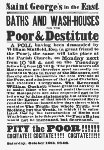 In
1844 the Association for Promoting
Cleanliness among the Poor
built baths and a laundry for the 'destitute poor'
in
Glasshouse Yard [now John Fisher Street], which was used by 27,662
bathers and 35,480 washers in
its first year. Bathers and washers paid one penny, ironers a farthing.
The Association also provided whitewash, and lent buckets and pails.
Its success led to an Act of Parliament in 1846 'To encourage the
Establishment
of Baths and Wash-houses', funded from the rates. See here
for the major part that William
Quekett, Lecturer and Curate of the parish, played in this - against initial opposition from the parish vestry - arguing that it was both philanthropic and would in the long term bring
savings to ratepayers [1846 handbill right]. In Curiosities of London: Exhibiting the Most Rare and Remarkable (1855), p33, John Timbs opined ...
so strong was the love of cleanliness thus encouraged that women often
toiled to wash their own and their children's clothing, who had been
compelled to sell their hair to purchase food to satisfy the cravings
of hunger. However, in 1850 the Vestry passed a resolution
objecting to the establishment of further facilities in the parish.
In
1844 the Association for Promoting
Cleanliness among the Poor
built baths and a laundry for the 'destitute poor'
in
Glasshouse Yard [now John Fisher Street], which was used by 27,662
bathers and 35,480 washers in
its first year. Bathers and washers paid one penny, ironers a farthing.
The Association also provided whitewash, and lent buckets and pails.
Its success led to an Act of Parliament in 1846 'To encourage the
Establishment
of Baths and Wash-houses', funded from the rates. See here
for the major part that William
Quekett, Lecturer and Curate of the parish, played in this - against initial opposition from the parish vestry - arguing that it was both philanthropic and would in the long term bring
savings to ratepayers [1846 handbill right]. In Curiosities of London: Exhibiting the Most Rare and Remarkable (1855), p33, John Timbs opined ...
so strong was the love of cleanliness thus encouraged that women often
toiled to wash their own and their children's clothing, who had been
compelled to sell their hair to purchase food to satisfy the cravings
of hunger. However, in 1850 the Vestry passed a resolution
objecting to the establishment of further facilities in the parish.
In 1848 the Quarterly Journal of the Statistical Society of London
(founded in 1834, now the Royal Statistical Society) demonstrated this new scientific method by publishing
a detailed report into the 'state of the poorer
classes', which can be viewed here, based
on the St Mary's sub-district
of the civil parish - chosen, they said, not because it was the worst
slum area in London (the extremes of overcrowding and poverty were to
come later) but because it was typical, and they were concerned to make
positive suggestions for improvement. They were motivated as much by public policy (avoiding civil unrest) as by philanthropic solicitude. Data
collected in 1845 was analysed in 27 tables, the latter
part of the report being particularly concerned to correlate the age of
parents with family size, mortality rates and health.
Local
government in London was chaotic, with various self-selected boards and
committees responsible for poor relief, highways and sewerage. For instance, there
were 136 Commissioners
for Sewers
for the Tower Hamlets, with a local office in Alie Street. There
were many fires in the area, but firefighting was unco-ordinated:
parishes had their own engines, as did insurance companies. See here for
a note on the development of the London Fire Brigade, and here for details of a local 18th century manufacturer of fire engines (who was churchwarden here in 1784).
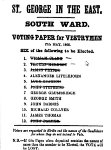
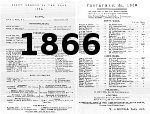
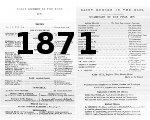 The main authority was the
Public Vestry,
elected each Easter by ratepayers. Sir Benjamin
Hall's Metropolis
Management Act of
1855 swept these away and created a Select
Vestry
(chaired by the
incumbent) and Boards for each parish. See here
for more details of this 'incorporation', in a restrospective paper of 1880 by the Vestry Clerk. (It also created the Metropolitan Board of Works - see here for details of its first clerk, later a local police court judge.) In 1856 the High Court dealt
with a dispute between the new Vestry and London Docks over the rate
levied on the Docks for street paving. It took over responsibility for
the local section of the Commercial Road when tolls were abolished in
1865. There was continued scope for electoral corruption where voters
were illiterate - left
is a completed voting paper for the 1862 vestry, together with lists of
parish officers for 1866 and 1871 (note the change from 'Vestrymen' to
'Guardians of the Poor'). More details of many of these men are given here. The clerk - usually full-time, and often a solicitor (as with W.L. Howell,
in post at the time of the Ritualism Riots; he was also the Registrar
for one of the sub-districts of Gt George's East) - was a key
person. Salaries for this post varied widely, depending on local
history and the energy and contacts of the postholder;
here he was paid £500 but had to pay his staff from this (as did his
counterparts at Bethnal Green, on £750, and St Luke Old Street, on
£800).
The main authority was the
Public Vestry,
elected each Easter by ratepayers. Sir Benjamin
Hall's Metropolis
Management Act of
1855 swept these away and created a Select
Vestry
(chaired by the
incumbent) and Boards for each parish. See here
for more details of this 'incorporation', in a restrospective paper of 1880 by the Vestry Clerk. (It also created the Metropolitan Board of Works - see here for details of its first clerk, later a local police court judge.) In 1856 the High Court dealt
with a dispute between the new Vestry and London Docks over the rate
levied on the Docks for street paving. It took over responsibility for
the local section of the Commercial Road when tolls were abolished in
1865. There was continued scope for electoral corruption where voters
were illiterate - left
is a completed voting paper for the 1862 vestry, together with lists of
parish officers for 1866 and 1871 (note the change from 'Vestrymen' to
'Guardians of the Poor'). More details of many of these men are given here. The clerk - usually full-time, and often a solicitor (as with W.L. Howell,
in post at the time of the Ritualism Riots; he was also the Registrar
for one of the sub-districts of Gt George's East) - was a key
person. Salaries for this post varied widely, depending on local
history and the energy and contacts of the postholder;
here he was paid £500 but had to pay his staff from this (as did his
counterparts at Bethnal Green, on £750, and St Luke Old Street, on
£800).


 St George's Town Hall
on Cable Street was originally the Vestry Hall, built in 1861 at a cost of
£6,000. (Prior to this the Vestry met in a room on the south-west corner of the church.) Left are
details of contracts entered into by the Vestry in 1862 and 1864 for
public works, including street lighting, 'cleansing and watering' the
streets and 'removal of dust', paving and sewerage, and work on the
Vestry Hall. See here
for the story of William Cooke, one of the three parish rate
collectors in 1866, who held various other offices in the parish in his
time, and was also an undertaker. Right is a ticket for a dinner held there in 1874 to mark the Duke of
Edinburgh's marriage. [The
1899 London
Government Act
replaced Vestries with 28 Borough Councils,
when the new Stepney Borough
Council took over the building as a local Town Hall; since the creation
of the London Borough of Tower Hamlets in 1963 it is now used for
a variety of local projects.] Some local streets bear vestry members' names: for
example, Fairclough [formerly North], Dellow [formerly Victoria] and Stutfield [formerly Elizabeth] Streets.
St George's Town Hall
on Cable Street was originally the Vestry Hall, built in 1861 at a cost of
£6,000. (Prior to this the Vestry met in a room on the south-west corner of the church.) Left are
details of contracts entered into by the Vestry in 1862 and 1864 for
public works, including street lighting, 'cleansing and watering' the
streets and 'removal of dust', paving and sewerage, and work on the
Vestry Hall. See here
for the story of William Cooke, one of the three parish rate
collectors in 1866, who held various other offices in the parish in his
time, and was also an undertaker. Right is a ticket for a dinner held there in 1874 to mark the Duke of
Edinburgh's marriage. [The
1899 London
Government Act
replaced Vestries with 28 Borough Councils,
when the new Stepney Borough
Council took over the building as a local Town Hall; since the creation
of the London Borough of Tower Hamlets in 1963 it is now used for
a variety of local projects.] Some local streets bear vestry members' names: for
example, Fairclough [formerly North], Dellow [formerly Victoria] and Stutfield [formerly Elizabeth] Streets.
It
was the
Vestry that elected churchwardens for the
parish each year. Wardens did not have to be members of the Church of England (for example, Elijah Goff,
warden 1797 and 1798, was a member of the Presbyterian chapel in Broad
Street, and others had no religious affiliation). Meetings could be
'packed' to secure the appointment of
wardens hostile to the church and Rector, as happened regularly in the
coming years, particularly when Bryan King was Rector. [Even though Parochial
Church Councils were created by the 'Enabling Act' of
1919, churchwardens are still technically appointed by residents of the
parish rather than church members, though these days this is mainly a
technicality, and wardens have to be 'actual communicants' in the Church of England.]
Under
the 1855 Act, Medical Officers of
Health
were appointed for each
District. The Registrar General published weekly, monthly and annual
Tables of births and deaths, classified by causes - see here
for the
1858 categories. ('Bills of Mortality' had been published in London
since the late 16th century.) For example, in the first quarter of 1858
in the St George-in-the-East District there were 55 deaths from
measles, 12 from scarlatina, 45 from whooping cough, 2 from diarrhœa
and 7 from typhus; 26 men and 39 women died in the parish workhouse: see here
for the full figures. It was the only district where the rate of deaths
from scarlet fever fell between 1851-60 and 1861-70. The MoH's annual report was published by the Vestry.
The
population of the civil district of St George-in-the-East given in the
1861 census was 48,961, of whom 31,106 (65.58%) were born locally, 4004
(8.19%) in Ireland, and 2,361 (4.83%) in 'foreign parts'.
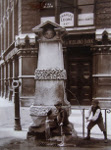

The Metropolitan Sanitary Commission had made its first report in 1848 - see here
(p17) the evidence of R. Bowie, surgeon, who had been practising in
Burr Street, East Smithfield, at the time of the 1832 cholera outbreak.
Between 1854-55
the quality of water provided by the various companies was monitored,
and reported to the General Board of Health (Medical Council) - this
was to become significant in checking the spread of the disease, which had
previously been thought to be transmitted by air rather than water (see Steven JohnsonThe Ghost Map (Penguin 2008) for an
imaginative account of this issue). Two
samples from the East London Company produced a scary
result [right]. See here
for the gruesome story of Aldgate Pump, far right in 1908 (at the junction of Fenchurch
and Leadenhall Streets: 'east of Aldgate Pump' became a common term for
the East End), and its historical associations. Its 'mineral salts'
were prized until it was
discovered that this was the result of calcium from human bones
leeching into the water; it was connected to a mains supply in 1876.
Another cause of death, common in this area, was the result of baby farming,
whereby daily nurses were hired to take charge of the unwanted children
of prostitutes and others, on the tacit understanding that they would
die of neglect and starvation (often recorded as 'marasmus'). The
practice was exposed by the journalist James Greenwood as one of The Seven Curses of London (Stanley Rivers 1869, chapter 3) and is explored is this paper by Dorothy Haller.
Linked to the new public health provisions were slum clearance
powers. Under the 'Torrens Acts' (the Artisans and Labourers' Dwellings
Act 1868, amended 1879 and 1882 - resulting in the curious 'short'
title 'Artisans* and Labourers Dwellings Act (1868) Amendment Act (1879)
Amendment Act (1882)' - owners could be
forced to repair or to demolish
individual dwellings, though the provisions for rehousing that
would have given it 'teeth' failed
to get through Parliament. (William Torrens was the Liberal MP for Finsbury at the time.) More significantly, the 'Cross Acts' (the Artisans* and
Labourers Dwellings Improvement Act 1875, amended 1879 and 1882) enabled compulsory purchase of whole
areas, with landowners compensated (R.A. Cross was Disraeli's Home Secretary). 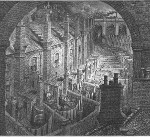 The St George-in-the-East
Vestry was among a number of local authorities that, for various
reasons, made limited use of these powers. However, see here
for the Rector's delight at the condemning of over 200 of properties by
our Medical Officer of Health immediately after the passage of the 1875
Act; here for details of the Whitechapel Estate, a major '5% philanthropy' scheme
just outside the civil parish (and now within the ecclesiastical
parish), promoted by the Metropolitan
Board of Works and the Peabody Trust; and here
for the adjacent Katharine Buildings project in Cartwright Street,
creating housing for those beyond the reach of
other providers. The legislation was consolidated
as Parts I and II of the 1890
Housing of the Working Classes Act.
The St George-in-the-East
Vestry was among a number of local authorities that, for various
reasons, made limited use of these powers. However, see here
for the Rector's delight at the condemning of over 200 of properties by
our Medical Officer of Health immediately after the passage of the 1875
Act; here for details of the Whitechapel Estate, a major '5% philanthropy' scheme
just outside the civil parish (and now within the ecclesiastical
parish), promoted by the Metropolitan
Board of Works and the Peabody Trust; and here
for the adjacent Katharine Buildings project in Cartwright Street,
creating housing for those beyond the reach of
other providers. The legislation was consolidated
as Parts I and II of the 1890
Housing of the Working Classes Act.
[ * Sometimes spelt 'Artizans'] Right is the famous illustration 'Over London - By Rail' by Gustave Doré in Blanchard Jerrold's London - A Pilgrimage (1872).
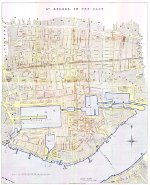 The age of district churches, and buildings
The age of district churches, and buildings
Although
the parish was geographically small (just 244 acres), by the
mid-19th century it had become densely populated, and much energy
went into building, or taking over from other denominations, additional
churches - some of which became separate parishes. Each of them had its
complement of halls, institutes, schoolrooms and other premises. Click
on the links for details of each of them, and here for details of baptism and weddings registers. This 1862 map shows
the
churches nearest to St George's, and this 1878 map
[right] gives a detailed picture of the area for which the Vestry was
responsible (which included the area of the 'daughter' churches, and
most of Wapping).
Anglican churches or
parishes founded by St George-in-the-East
|
Two further
parishes were later incorporated into
St George's parish (and the boundary with St Peter London Dock was
adjusted in
1989, transferring the St Katharine's Dock area to St Peter's):
former Anglican
parishes which are part of the present-day parish
|
In
the 17th and 18th century dissenters, and churches serving foreign
nationals, were rather more active locally than the Church of England
or the Roman Catholic Church. By the middle of the 19th century that
had changed; in answer to the question posed in 1851 Are there may Dissenters in your
parish? Bryan King
observed (though how accurately?) There
are not many DIssenters; in fact, the people are too poor to support
either Dissenters or any teachers without extraneous aid. However, there had been a huge variety of such
places of worship in the parish, chronicled here:
(former)
churches of other denominations
|
There
are also pages about the history and growth of various areas of the
present-day parish (some of them previously in adjacent, now merged, parishes):
- Precinct of Wellclose, once a Liberty of the Tower of London, and
Wellclose Square, a centre of 'liberty'
- Goodman's Fields
- theatres, Prescot Street, Leman Street
- Magdalen Hospital for the reception of Penitent Prostitutes
- East Smithfield, including the Royal Mint
- Ratcliff Highway, including the famous murders of 1811-12
- Cable Street
from earliest times to the present day
- Rosemary Lane
and Rag Fair
- Backchurch Lane and Pinchin Street
- St John's parish
- Cannon Street Road and Ponler Street
- Sugar Refining; Wool and Tobacco warehouses
- housing - Peabody Estate, Katharine Buildings, and for a much later period St George's Estate
- Hessel Street
- a centre of Jewish life
- Synagogues
throughout the parish, reflecting the steady growth of its Jewish
population
- Watney Street
- Chapman Street [now Bigland Street] area
- Schools in the parish
- Workhouse and Infirmary
- The Fortunes of the clergy - an explanation of the history of stipends and the struggle to make ends meet
- Churchwardens and their families - 18th century and 19th century
|
At
the time of the Great Exhibition of 1851* (when Dr Worthington,
incumbent of Trinity Church, Gray's Inn Road, offered to conduct
services, if
required, in the Greek, Latin, French or Italian tongues)
a booklet of service times throughout London was published by Sampson
Low. It lists the services for this parish as
¶ George's,
St., in the East, parish church. Between 9 and 10, Cannon
street.
Revs. B. King, rector; W. Quekett, lecturer. 11, morning ;
3½, afternoon. Lord's supper, first Sunday in
month.
¶ Christ
Church,
Watney street, Commercial road, East. Revs. W. Quekett,
incumbent; G.
Mockler, curate. 11, morning; 3½, afternoon; 6½,
evening.
Wednesdays, Fridays, and Saints' days, 11, morning. Lord's supper,
last Sunday in month — Seats to be had of Mr. C. J. Osborne,
18,
Cannon street.
¶ St.
Mary's, Johnson street, Commercial road east. Rev. W.
M'Call,
incumbent. 11, morning ; 6½, evening. Thursdays, 7, evening.
Lord's
supper, first Sunday in month, after morning service; third ditto,
8¼, morning. There is also a service on the fourth Sunday in
month,
3, afternoon. — Seats to be had after the Thursday
service.
¶ St.
Matthew's Episcopal Chapel, Pell street, St. George street, near
Wellclose square. Rev. D. Moore, minister. 11, morning;
6½,
evening. Lord's supper, second Sunday in month. — Seats may
be had
of Mr. Butler, 42, Wellclose square.
¶ Trinity Episcopal
Chapel,
Cannon street road. Rev. H. Robbins, incumbent. 11,
morning; 6½,
evening. Wednesdays, 7, evening. Lord's supper, third Sunday in
month.— Seats to be had of the chapelwarden.
|
[*
In 1857 William Quekett, who had served energetically in this parish
but was by then the Vicar of Warrington, organised a grand railway
excursion from there to London to see the sights, including the Crystal
Palace from the Great Exhibition, by then relocated to Sydenham - you
can read about it here.]
The first-ever nationwide census of religious attendance was
conducted on Mothering Sunday 1851; here
are the figures for the borough of Tower Hamlets, with some comments. In 1859 there were 467 marriages in the
registration district of St George-in-the-East: 281 in the Church of
England, 172 Roman Catholic, 7 in other Christian churches and 7 under
the auspices of the Superintendent Registrar [i.e. civil ceremonies].
Ritualism Riots, 1859-60
The
one thing many people know about St George-in-the-East is that there
were riots in church over matters of ritual and ceremonial. It
is
an extraordinary tale, which has been extensively written about; you
can find a summary here.
We marked their 150th anniversary with a programme of special events, including a visit by the Archbishop of Centerbury.
Parish worship after 1860
After the riots, things calmed
down. Ironically, since those days worship at St George's
has been of a 'central' character, alongside our high and low church
neighbours! The pattern of Sunday worship in 1863, according to a somewhat cursory (and perhaps incomplete) Guide to the Church Services in London and its suburbs,
was 11am (HC on the first Sunday), 3.30pm and 7pm, with a weekday
service on Tuesday at 7pm. By 1875 - when Harry Jones had been Rector
for two years - it was
as follows (see also Dickens' Directory of London
for 1879):
| Services Sunday
HC 8.00, 1st S and greater festivals, 11.45, M 11.00, E with
churchings 3.00, E with baptism 4.15, E 7.00; Daily, M 11.00;
Festivals M 11.00, HC am. Choir, partly paid. Music, Anglican.
Surplice in pulpit. Seats 1200, all free. Offertory, at each service. |
Weekday Matins at 11am was a pattern in other parishes at
this period - and often well-attended. Note the inclusion of 'surplice
in pulpit', in the light of the Ritualism Riots. Seats...all free; offertory shows that the parish had managed to abolish pew rents, and took collections. See here
for the evidence presented by the Rev G.H. McGill of Christ Church
Watney Street (on behalf of Stepney deanery clergy) to the Select
Committee on the Ecclesiastical Commission in 1862, which gives
detailed facts and figures showing how hard it was to sustain parish
finances with uncollectable pew rents, practically no help from local
businesses, and limited or non-existent endowments in the new district
churches; and here
for the case made by Harry Jones in 1875 against the creation of
district churches, for a variety of reasons, including financial.
Schools
A
major change in education provision came with the 1870
Education Act - see here for details of its impact locally, and of all the Board Schools that were built in the parish and their subsequent fate.
Church and community
The parish workhouse and infirmary, and the poor law schools, loomed large in the local consciousness. Here
and here
are
the two parts of an 1866 newspaper article describing the
experience of a 'female casual' in the workhouse. Charles Dickens, in chapter 3 of The Uncommercial Traveller
(a collection of his sketches about various parts of London)
describes in graphic detail a visit to Wapping Workhouse - passing en route
'Mr Baker's trap', a site of many suicides named after the local
coroner; it makes grim reading, but he concludes that the workhouse was
an establishment highly creditable to those parts, and thoroughly well administered by a most intelligent master. He
called for an equalisation of Poor Law rates across London, finding it
absurd that the poorest districts had to find the highest rates: 5s.6d.
in the pound in one East End parish, as against 7d. in the pound in St
George Hanover Square!
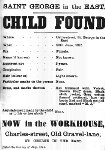 By
1870, for the first time, the district was classed as one of the five
poorest in London. But the St George-in-the-East Poor Law Guardians
- like their counterparts in Stepney and Whitechapel - virtually ceased
making 'out-relief' payments (as opposed to
'in-relief' - the workhouses). This was partly because of the growing
influence of the Charity Organisation Society which
pressed for more targeted assistance.
By
1870, for the first time, the district was classed as one of the five
poorest in London. But the St George-in-the-East Poor Law Guardians
- like their counterparts in Stepney and Whitechapel - virtually ceased
making 'out-relief' payments (as opposed to
'in-relief' - the workhouses). This was partly because of the growing
influence of the Charity Organisation Society which
pressed for more targeted assistance.
John Marius Wilson's Imperial Gazetteer of England and Wales (1870-72) gives the following statistics and other details:
Acres,
243. Real property in 1860, £182,734; of which £600 were in gas-works.
Population in 1851, 48,376; in 1861, 48,891. Houses, 6,169 ... The parish church ... is a noble and massive structure, in the Doric style;
has a lofty tower at the west end, unlike any other in England; has
also four smaller towers ... St. Matthew's church, in Pell-street, has a good spire ...
The head benefice is a rectory ... Christchurch, St Mary, and St. Matthew,
are vicarages, and St. Peter is a perpetual curacy ... Christchurch was constituted in 1841, St. Mary's in 1850; St.
Matthew's in 1860; St. Peter's, in 1866. Population of Christchurch, 13,145; of St. Mary, 5,515; of St. Matthew, 3 245; of St. Peter, 8,354.
Value of St. George, £396; of Christchurch, £300; of St. Mary, £150;
of St. Matthew, £183; of St. Peter, £420.
The places of worship,
in 1851, were 5
of the Church of England, with 5, 880 sittings; 1 of Independents, with
700 sittings; 1 of Baptists, with 560 sittings; 2 of Wesleyan
Methodists, with 1,550 sittings; 1 of New Connexion Methodists, with 92
sittings; 1 of Primitive
Methodists, with 337 sittings; 1 of Wesleyan Reformers, with 290
sittings; 1 of
Lutherans, with 150 sittings; 2 undefined, with 120 sittings; and 1 of
Roman
Catholics, with 360 sittings.
The schools were 9 public day schools, with 2,220 scholars; 86 private day schools, with 2,211 scholars; 13 Sunday
schools, with 3,053 scholars.; and 7 evening schools for adults, with 119
scholars.
The district is divided into the sub-districts of St. Mary, St.
Paul, and St. John; and is aggregately conterminate with the parish.
Acres of the sub-districts, 62, 84, and 97. Population 18,181; 21,015; and
9, 695. Houses, 2,384; 2,793; and 992. Poor-rates in 1862, £32,243.
Marriages in 1860, 410; births, 1,880 - of which 90 were illegitimate;
deaths, 1,293, - of which 671 were at ages under 5 years, and 12 at
ages above 85. Marriages in the 10 years 1851-60, 3,744; births, 18,743; deaths, 13,178. The workhouse is in St. John sub-district; and
had 304 male inmates and 514 female inmates at the census of 1861.
|


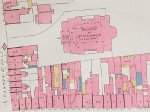
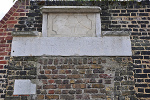 In 1883 St George's Mission House
at 136 St George's Street [later renumbered 181 The Highway] was built at the cost of £5000
- a susbstantial building on three floors with acommodation
above. Goad's 1887 insurance map show that it had a wine store to
the left, and a colour works and chemical packaging company on the
right, and the whole area around the south and west of the church was
built up. The hall
was demolished after 1962, when The Highway was widened. You
can still see the headstone of the rear door in the wall by the church [pictured] - a separately-listed feature.
In 1883 St George's Mission House
at 136 St George's Street [later renumbered 181 The Highway] was built at the cost of £5000
- a susbstantial building on three floors with acommodation
above. Goad's 1887 insurance map show that it had a wine store to
the left, and a colour works and chemical packaging company on the
right, and the whole area around the south and west of the church was
built up. The hall
was demolished after 1962, when The Highway was widened. You
can still see the headstone of the rear door in the wall by the church [pictured] - a separately-listed feature.
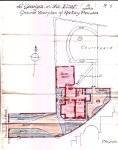 There was also a small parish room built on the north-west corner of
the Rectory, at some point before 1890 [plan of house and garden left] - when was it demolished?
There was also a small parish room built on the north-west corner of
the Rectory, at some point before 1890 [plan of house and garden left] - when was it demolished?
In
1891, at the time when St Matthew Pell Street closed as a church (though continued in use for other activities), Tait Street
Mission Room was built at a cost of £1050, of which £918 had
been raised by the time of its opening
by Princess Helene Frederica Augusta, Duchess of Albany. (Tait Street,
just beyond the railway to the east of Cannon Street Road, was
named after Archibald Campbell Tait, Bishop of London and later
Archbishop of Canterbury, who had visited the area during cholera
epidemics - though had done little to help the parish through the
Ritualism Riots.)
At
the opening ceremony the Rector said
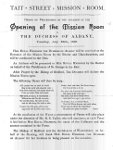 The
room ... may be regarded as a daughter mission room to the larger one
[on The Highway] ..... In the organisation of the parish it will take
the place of an Arch of the Blackwall Railway where for the last two
years a successful mission work has been carried on. This arch is now
required for the purposes of the Railway and it has been necessary to
find other quarters for the mission. The Walburgh Street Arch is not
given up without regret, for there are many who have cause to remember
with much thankfulness its happy success; but it must be confessed that
a Railway Arch with its constant noise of trains rumbling overhead and
with its cold draughtiness is not a convenient place either for
services or for meetings, and there is every reason to hope that the
good work will be continued with even an increased success in the Tait
Street Mission Room ... The
room ... may be regarded as a daughter mission room to the larger one
[on The Highway] ..... In the organisation of the parish it will take
the place of an Arch of the Blackwall Railway where for the last two
years a successful mission work has been carried on. This arch is now
required for the purposes of the Railway and it has been necessary to
find other quarters for the mission. The Walburgh Street Arch is not
given up without regret, for there are many who have cause to remember
with much thankfulness its happy success; but it must be confessed that
a Railway Arch with its constant noise of trains rumbling overhead and
with its cold draughtiness is not a convenient place either for
services or for meetings, and there is every reason to hope that the
good work will be continued with even an increased success in the Tait
Street Mission Room ...
(The Mission Room was later taken on by the British Legion.)
|
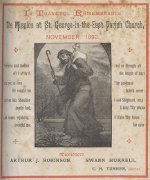
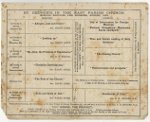 As in many parishes, formal missions
were organised (though Harry Jones, Rector 1873-82, was not a fan - see why here).
In the major London-wide mission of 1884-5, the missioners appointed
for St George-in-the-East were the Revd W.M. Sinclair, Vicar of St
Stephen Westminster; for Christ Church, The Revd Wladislaw Somerville
Lach-Szyrma of St
Peter Newlyn, Penzance but later of Barkingside (his Polish father had
fled persecution and married into a naval family - several descendents
became Anglican clergy);
and for St John the Evangelist-in-the-East, The Rev E. Bickersteth,
Rector of Framlingham, and the Hon and Rev R. E. Adderley, Curate of
All Hallows Barking (both from famous clerical families, and
experienced mission speakers). [Right is the Advent programme for 1878, and an 1893 mission card.]
As in many parishes, formal missions
were organised (though Harry Jones, Rector 1873-82, was not a fan - see why here).
In the major London-wide mission of 1884-5, the missioners appointed
for St George-in-the-East were the Revd W.M. Sinclair, Vicar of St
Stephen Westminster; for Christ Church, The Revd Wladislaw Somerville
Lach-Szyrma of St
Peter Newlyn, Penzance but later of Barkingside (his Polish father had
fled persecution and married into a naval family - several descendents
became Anglican clergy);
and for St John the Evangelist-in-the-East, The Rev E. Bickersteth,
Rector of Framlingham, and the Hon and Rev R. E. Adderley, Curate of
All Hallows Barking (both from famous clerical families, and
experienced mission speakers). [Right is the Advent programme for 1878, and an 1893 mission card.]
In 1888 the British
Weekly
conducted a London-wide census of attendance at places of worship;
unlike that of 1851, it did not include Sunday School scholars. here
are the figures for the churches within the civil district of St
George-in-the-East (wider than the parish). It records attendances at
the parish church of 292 in the morning and 425 in the evening.
There
are various contemporary accounts of parish
life:
- In 1875 Harry
Jones, the Rector (who created St George's Gardens) published a
readable account East & West London
[included on this site over four pages] comparing the two worlds. (See further comment on Jones' style here.)
He
described the local trades (the German sugar refining trade collapsed
soon afterwards), and Jamrach's Emporium on The Highway, where you
could buy any kind of wild animal - see here for more details.
- Harry Jones also
commented on Charles Dickens' The Mystery of Edwin Drood, parts of which were set in an opium den in the
parish - though debate continues about the details. In 1884 he wrote Charles Dickens used to come here and grub for sensational localities. He found them. Dickens
had long visited the area - in 1860 he went to the female ward of the
workhouse. In a recent talk in church 'Charles Dickens and the East End
of London' Charles West said, appositely, that the East End's greatest
gift to DIckens was sharing the chalice of adversity.
- Charles Dickens
Jnr's Dictionary of
London (1879) describes the dancing-rooms and
cafés and opium dens of Ratcliff Highway; see here for his comments on one of its common lodging houses.
- In 1880 the curate
R.H. Hadden produced An East End Chronicle [link provides full transcribed text; it can also be viewed online here] which remains the most complete account of
the first 150 years of the parish. (The introduction was written by the
Rector, Harry Jones, who was travelling in Jerusalem at the time; proceeds of sale were for the organ
fund.)
- For some years from 1884 a monthly journal Eastward Ho! was published by Wells, Gardner, Darton & Co, as a medium of thought between East and West London, and
included graphic accounts of parish life, with appeals to university
men living and working in London to visit the area and get involved.
- Charles Booth's
1889 & 1898 Poverty
Maps
classified every street, and is a rich and fascinating
resource, not least for the contrast between his original research and
its update a decade later, based on detailed notes taken by inspectors
carefully walking each patch in the company of local
police officers. (Modern-day government pronouncements
about the lives of the 'undeserving poor' living on welfare show no
such rigour; despite an approach which was often equally patronising,
the Victorians had at least done their research thoroughly, and knew in
great detail
what life was really like.) Digitised facsimilies of some of these
survey
notebooks are also on the
Charles Booth site; a transcript of one of them, which also includes comments on the area, is here, and the 1888 list of tailors working in the parish is here.
The update
shows some improvements - which surely were in part the
result of
the intensive church presence and activity. In 1902 he published a
narrative account, based on observations from the previous few years;
the section relating to this area (with comments on Jewish settlement,
churches of various denominations, charities and local government) can
be read here.
- Here
is part of a somewhat pious and sentimental - but interesting in its
details - account that appeared in various church papers around 1895,
claiming major improvements in the character of the area, including a
Sunday evening congregation at the parish church of 500 - respectable working people: Rector Turner observed that out of a population of ten thousand, scarcely half a dozen families keep a domestic servant - plus many more connected to the simpler services of the mission churches, and the Sunday schools and bible classes.
In
addition,
- Details of all the
known pubs, inns, taverns and beer houses can be found here and here [two links to the same excellent site] or - with a list of all those in the civil district of St George-in-the-East - here
- The Vestry map
of 1878 shows the streets and alleys of St George-in-the-East local
government area (wider than the then-parish, as explained above) in detail.
- The fire insurance maps of Charles E. Goad
Ltd,
a London-based firm (but mapping many other parts of the country
too), originating in 1885 and updated until quite recent times, are an
invaluable resource because they are so detailed (on a scale of 1:480 -
1 inch to 40 feet), giving street numbers, the nature of premises (D =
dwelling, S = shop, PH = public house and so on) and names of many
businesses, as well as much information relevant for insurance
(such as construction materials - red = brick or stone, yellow =
wooden, light blue/purple = skylights; boilers; doors and shutters;
hydrants; fire alarm boxes; hydrants, and many dimensions - here is the
full key). The British Library website includes zoomable and printable
versions covering most of area covered by our parish and beyond, as detailed here,
running broadly from west to east:
Volume 5 (1887)
099 (St Katharine's Docks), 102 (Upper East Smithfield, and part of Docks), 103 (western end of St George Street & Pennington Street, and vaults), 104 (St George Street & Pennington Street west of Cannon Street Road
(including Denmark and Betts Street, and Prince's Square with the
Swedish chapel), 105 (St George Street & Pennington Street east of Cannon Street Road, including the church site)
119 (north of Royal Mint Street - part of Goodman's Field area), 120 (between Upper East Smithfield and Royal Mint Street, with railway and Peabody Buildings)
Volume 11 (1899)
338 (Gowers Walk to Batty Street, between Ellen Street and Commercial Road), 339 (William Street to Commercial Road), 340 [missing], 341 (Christian Street to Cannon Street Road, north of Cable Street), 342 [missing], 343 (Tait Street west of Anthony Street to Commercial Road), 344 (Tait Street east of Anthony Street to Commercial Road, as far as Watney Street), 345 (Cable Street, Chapman Street area up to Tait Street), 346 (Cable Street to Watney Street, including St George's Gardens &c)
|
- PortCities
London provides a wealth of information about all aspects of
the history of the Docks
- Gordon
Barnes Stepney
Churches (Ecclesiological Society / Faith Press 1967)
gives further background information
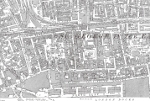
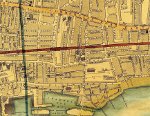
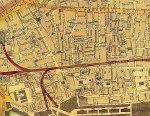 The East London History
Society
enables you to compare a range of old and new maps
side-by-side and has many other excellent features. Maps which it
does not feature include that of Weller in 1868 [right], which clearly shows the
location of the churches, and the 1894 Ordnance Survey map of part of the parish [far right].
The East London History
Society
enables you to compare a range of old and new maps
side-by-side and has many other excellent features. Maps which it
does not feature include that of Weller in 1868 [right], which clearly shows the
location of the churches, and the 1894 Ordnance Survey map of part of the parish [far right].- Here
are details of the clergy for 1860-1900.
After Bryan King's departure, patronage of the benefice passed to the
Bishop of London, to whom the Principal and Fellows of Brasenose
College transferred most of their East End patronage in return for
various country livings. In 1879 the Rector's stipend was increased by
£500 a year by the voidance of a City rectory, St Alphege London Wall.
The parish has never been regarded as an 'ecclesiastical prize', but
the Rector's stipend was now a comfortable £800 after deductions -
though from this they had to meet the expenses of assistant clergy and
other costs.
THE
TWENTIETH CENTURY
We
entered the new century with three churches - St George-in-the-East,
Christ Church Watney Street and St John-in-the-East Golding Street. All
were kept busy, with a full range of parish clubs, societies and
organisations, and buildings to match, including St George's Mission
House and the parish room behind the Rectory (see above), as well as St
Mathew Pell Street (now used as a parish hall) and Tait Street Mission
Room.
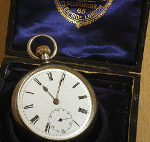
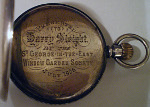 This interview with R.W. Harris
(Rector 1897-1903) in the Charles
Booth archive
[B222,
pages 150-179] details many of these parish organisations, and
reports
on the 'invalid kitchen', and the initiative of 'St
George-in-the-East Window Garden
Society' - a recognition that a windox box rather than a garden was the
closest many came to nature (see here for an 1865 initiative by the Royal Horticultural Society along these lines). In
1906 the winner of the annual
competition was the ten-year old Harry Sleight, who lived at 1 Redmead
Lane,
Wapping all his life until he was moved out by Docklands
redevelopment
in the late 1970s. He
was presented with an
inscribed silver pocket watch, which he treasured all his life, as does
his family - it is still in good working order (our thanks to his grandson Geoffrey for
these pictures).
This interview with R.W. Harris
(Rector 1897-1903) in the Charles
Booth archive
[B222,
pages 150-179] details many of these parish organisations, and
reports
on the 'invalid kitchen', and the initiative of 'St
George-in-the-East Window Garden
Society' - a recognition that a windox box rather than a garden was the
closest many came to nature (see here for an 1865 initiative by the Royal Horticultural Society along these lines). In
1906 the winner of the annual
competition was the ten-year old Harry Sleight, who lived at 1 Redmead
Lane,
Wapping all his life until he was moved out by Docklands
redevelopment
in the late 1970s. He
was presented with an
inscribed silver pocket watch, which he treasured all his life, as does
his family - it is still in good working order (our thanks to his grandson Geoffrey for
these pictures).

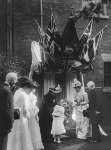


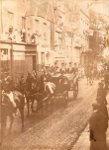
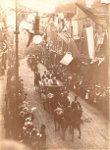 A high point in the time of F. St. J. Corbett
(Rector 1903-19) was the visit on 14 July 1904 of Queen Alexandra, wife
of King Edward VII, for a flower show and sale of work (the fourth
picture shows the Victorian extension to the Rectory), which provided a
welcome fillip to parish finances. The circumstances of her visit are
recounted in press cuttings here and an interview here.
A high point in the time of F. St. J. Corbett
(Rector 1903-19) was the visit on 14 July 1904 of Queen Alexandra, wife
of King Edward VII, for a flower show and sale of work (the fourth
picture shows the Victorian extension to the Rectory), which provided a
welcome fillip to parish finances. The circumstances of her visit are
recounted in press cuttings here and an interview here.
Services
at the parish church in this period were as follows:
Holy
Communion every
Sunday 8am & 12 noon, Greater Festivals also at 7am, Thursday
8.30am,
Saints' Days 10am
Matins
Sunday & Monday 11am, other days 10am Evensong Sunday
6.30pm, Weekdays 8pm (with sermon on Wednesdays)
Holy
Baptism Sunday 3.45pm & Wednesday 7.30pm
Churching
of Women
before or after any service Sunday School
10am & 3pm
|
Tait Street Mission remained active, with a men's meeting on
Sundays
at 4pm and a children's service at 8.30pm, as well as weekday
activities. There was a 'lady
worker', Miss Emily FitzHardinge Berkeley, living at the Rectory - more
details here. However,
despite a full round of activities here, at the parish church and St Mathew Pell Street, the parish was seriously struggling:
numerically (as the area became more Jewish in population),
financially, and pastorally. See the Rector's extremely
revealing confidential report
of 1914 to the Bishop of Stepney (plus the published accounts for
1915), which candidly sets out the difficulties. According to Mr
Corbett, the Bishop claimed not to be
aware of the extent of the lay team, or of the problems they faced.
And,
as was still common, the Rector had to pay the curate from his own
stipend; unlike his predecessor, he did not have a 'private' income.
Here
is a description of life in various parts of the parish in 1911.
The First World War and its aftermath
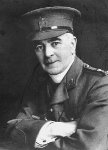 Then
came the Great War.
Clergy left to serve as chaplains on the
front, or, like our own Rector [pictured - more details here] remained in their parishes while serving units on the home front. They discovered (though
those who had served in the East
End surely knew already) how tenuous were the links of soldiers with
the Christian
faith: the church needed to change. (See
Alan WilkinsonThe Church of England and the First World War SCM
1996). Our
churches struggled: particularly in the last two years of the war,
numbers of baptisms and weddings fell sharply. In the post-war years
various national initiatives to 're-connect' were made - for example,
the National Mission of Repentance
and Hope, first launched in 1916, with William Temple as its
secretary. It
was also the time of
massive expansion of council housing, to provide 'homes fit for heroes'
in new outer suburbs; the population became more mobile. And it
was a time when the way the Church of England conducted its
business changed, with the introduction of what we now call synodical
government: see here
for more details.
Then
came the Great War.
Clergy left to serve as chaplains on the
front, or, like our own Rector [pictured - more details here] remained in their parishes while serving units on the home front. They discovered (though
those who had served in the East
End surely knew already) how tenuous were the links of soldiers with
the Christian
faith: the church needed to change. (See
Alan WilkinsonThe Church of England and the First World War SCM
1996). Our
churches struggled: particularly in the last two years of the war,
numbers of baptisms and weddings fell sharply. In the post-war years
various national initiatives to 're-connect' were made - for example,
the National Mission of Repentance
and Hope, first launched in 1916, with William Temple as its
secretary. It
was also the time of
massive expansion of council housing, to provide 'homes fit for heroes'
in new outer suburbs; the population became more mobile. And it
was a time when the way the Church of England conducted its
business changed, with the introduction of what we now call synodical
government: see here
for more details.
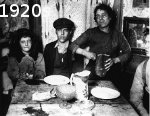
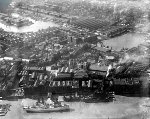 When
J.C. Pringle was appointed
Rector in 1919, although the range of
clubs and activities (particularly for girls) continued, with new ones
for children and adults added in the next few years,
congregational numbers remained low - see here for more
details. The bishop was not prepared to license a curate
to the parish; instead, a succession of licensed women workers was appointed.
Repairs to the church, including the installation of electric lighting
(partly funded by the sale by faculty of some historic church plate), delayed the installation of a war memorial until 1924 - see here for
details of the memorial, and the subsequent keeping of Armisticetide.
There is more about Pringle's ministry here,
and his connections with the Charity Organisation Society); and here
are some of his forthright, and often startling, opinions from the
parish magazine. Right
is a 1922 view of the docks, looking from the river towards the church,
and one of many images of local poverty from this period.
When
J.C. Pringle was appointed
Rector in 1919, although the range of
clubs and activities (particularly for girls) continued, with new ones
for children and adults added in the next few years,
congregational numbers remained low - see here for more
details. The bishop was not prepared to license a curate
to the parish; instead, a succession of licensed women workers was appointed.
Repairs to the church, including the installation of electric lighting
(partly funded by the sale by faculty of some historic church plate), delayed the installation of a war memorial until 1924 - see here for
details of the memorial, and the subsequent keeping of Armisticetide.
There is more about Pringle's ministry here,
and his connections with the Charity Organisation Society); and here
are some of his forthright, and often startling, opinions from the
parish magazine. Right
is a 1922 view of the docks, looking from the river towards the church,
and one of many images of local poverty from this period.
See these annotated street directories for 1921: St George's Street, Cable Street, Leman Street and Commercial Road.
Pringle's successor in 1925 was C.J.
Beresford, who as Warden of the
SPCK College in Commerical Road was already well-known in the parish:
had frequently provided 'cover' here
during Pringle's absences, both for the main Sunday services and for
baptisms. He had a wide circle of former students who
assisted in the parish. Unlike Pringle, he was allowed a curate, as
well as a parish
worker. He was also a musician - the founder of the Stepney Orpheus
Choir: see here
for details of the musical life of the parish, and arrangements for the
bicentenary in 1929.
There is more on Beresford's life and ministry here.
Some further extracts from the parish magazine 1923-34 can be found
here:
The
pattern of services in the 1920s and 30s remained 'central' in
tradition, with various small changes made over the period:
Holy
Communion
every
Sunday 8am, & 12 noon on all [later third only]
Sundays; choral at 11.30am
following shortened Mattins on the first Sunday;
Tuesdays and Holy
Days 7am, Thursdays 8am
Holy
Baptism Sunday 4pm & Wednesday 7.30pm Churching
of Women
before or after any service
Matins
Sunday 11am, most weekdays 8am Evensong Sunday
6.30pm, Wednesday 8pm [with address], most other weekdays 6pm
Sunday
School 3pm [with the introduction of a Children's Service on
the fourth Sunday] |
See this
page for the involvement of Earl Winterton MP and his wife in parish
affairs during the inter-war years. He was a local landowner and
employer, and built some 'philanthropic housing' in the parish. But
slum housing remained the norm, with big profits for absentee landlords.
 Left
are Miss E K Palmer and Mr J Day, churchwardens for
1937. Miss Palmer had been Superintendent of the Sunday School for
many years, and a key figure in the parish. Female wardens were not
yet common in the Church of England - but we were becoming a
progressive parish! Their churchwardens' staves remain in use.
Left
are Miss E K Palmer and Mr J Day, churchwardens for
1937. Miss Palmer had been Superintendent of the Sunday School for
many years, and a key figure in the parish. Female wardens were not
yet common in the Church of England - but we were becoming a
progressive parish! Their churchwardens' staves remain in use.
Sydney
Maddocks wrote wistfully in 1933
Over
the parish in our days hangs an atmosphere of depression that things
should be as they are, which is broken only for some rare moments, such
as when the mean streets have a certain wistfulness in the softening
grey haze of a late autumnal afternoon. Then the lofty tower of St.
George’s Church, which has seen two centuries of
life’s
vicissitudes, hushes red in the kindly glow of the sun in the west,
telling worker and the workless of the departure of another day.
(Co-Partnership
Herald, vol.2, no.24)
Politics
became more volatile throughout the period, with widespread
unemployment in the 1920s leading to the General
Strike, and the rise of both
communism and fascism, resulting in the Battle
of Cable Street in 1936 - see here for
more details.
The
Second World War - Blitz and Rebuilding
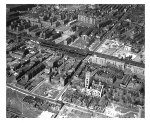
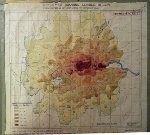
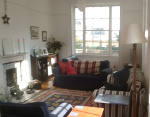 When the
Second World War began, clergy were again in short supply, and six
local parishes were grouped together; St John's was closed. On 16 April
1941 Christ Church
and its vicarage were destroyed by a landmine, and St George's was
gutted the next month. Writing of the bombing of the parish, the Communist councillor (and MP from 1945) Phil Piratin said We saw them coming over against the bright blue sky. A policeman said 'better get in'. Then the bombs began to drop. All remaining clergy, led by Fr John Groser
from
Christ Church,
moved to the
Rectory, where services were held in the living room [left today] - including a daily eucharist, without a break - until they moved into the
'Upper Room' of the Mission House the following year (some years later,
a service was held for the renewal of vows of those married there -
including Ros Rowley, with whom we are still in touch). Nora Neal also joined the team as a licensed lay worker during the war
years. From 1942 the crypt was used (by
faculty) as an air-raid shelter. Right is a map of the bombing across London - see also this interactive website - and a local aerial view from 1960. Ritchie Calder Carry On London! (English University Press 1941) contains many personal stories. See here for a peace party in Walburgh Street.
When the
Second World War began, clergy were again in short supply, and six
local parishes were grouped together; St John's was closed. On 16 April
1941 Christ Church
and its vicarage were destroyed by a landmine, and St George's was
gutted the next month. Writing of the bombing of the parish, the Communist councillor (and MP from 1945) Phil Piratin said We saw them coming over against the bright blue sky. A policeman said 'better get in'. Then the bombs began to drop. All remaining clergy, led by Fr John Groser
from
Christ Church,
moved to the
Rectory, where services were held in the living room [left today] - including a daily eucharist, without a break - until they moved into the
'Upper Room' of the Mission House the following year (some years later,
a service was held for the renewal of vows of those married there -
including Ros Rowley, with whom we are still in touch). Nora Neal also joined the team as a licensed lay worker during the war
years. From 1942 the crypt was used (by
faculty) as an air-raid shelter. Right is a map of the bombing across London - see also this interactive website - and a local aerial view from 1960. Ritchie Calder Carry On London! (English University Press 1941) contains many personal stories. See here for a peace party in Walburgh Street.
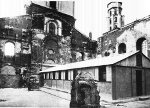
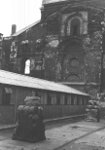
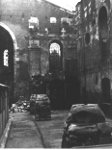
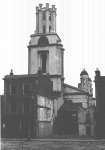
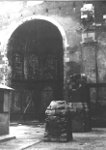
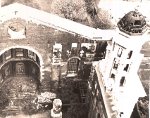
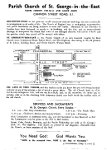
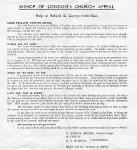 In December
1943 a prefab within the
shell of the church, 'St George-in-the-Ruins' - above left - became
the parish's home for the
next seventeen years. This leaflet circulated at the end of the War explains the pastoral
re-organisation of the parish, and the pattern of worship in what is
optimistically described as the charming little temporary church now built inside the roofless walls of the old church. By contrast, Prebendary Arthur Royall, a chronicler of East London Church life (who died in 2013), commented I
worshipped there one Sunday morning in the late 1940's and have vague
memories of what appeared, from the outside, to be a large shabby
wooden shed. Right is the first appeal for funds to rebuild the church.
In December
1943 a prefab within the
shell of the church, 'St George-in-the-Ruins' - above left - became
the parish's home for the
next seventeen years. This leaflet circulated at the end of the War explains the pastoral
re-organisation of the parish, and the pattern of worship in what is
optimistically described as the charming little temporary church now built inside the roofless walls of the old church. By contrast, Prebendary Arthur Royall, a chronicler of East London Church life (who died in 2013), commented I
worshipped there one Sunday morning in the late 1940's and have vague
memories of what appeared, from the outside, to be a large shabby
wooden shed. Right is the first appeal for funds to rebuild the church.
The Mission Hall at 181
The Highway remained in use until its demolition after 1962. During and
after the war there was a men's club - used particularly by dockers -
in the dingy basement, with snooker/billiards and table tennis. An
older resident remembers how, when tea and cheese were rationed, they
provided hot Bovril and a roll (you brought your own filling) for three
halfpence, and the introduction of a Dansette record player separated
the boys from the girls. From 1960 until its demolition around 1962,
there was a youth club in the main hall, run by Andrew Quicke and Leo Aylen; Tricia Wyeth ran a canteen with tea and cheese rolls which she bought after school and made up.
In 1945 an Anglican Franciscan
presence was established at 84 Cable Street [where Noble Court now stands]; you can read more here
about their
work, and
how this became the starting-point of Fr Ken Leech's commitment to the
East End.
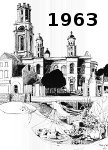
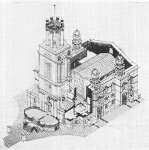
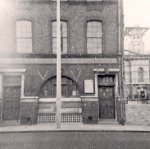
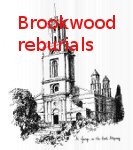 In
1960, now with Fr Alex Solomon as Rector, the congregation
moved out of the prefab for the new church to
be constructed, and for 3¾ years they worshipped in the 'Upper Room' of
the old mission hall pictured left in 1960]. 686 coffins were moved out of the crypt and
reburied at
Brookwood
Cemetery [listed left]. The
detailed story of the whole process is told here
by Fr Solomon, and the new church is described in detail here; see also a 1959 architectural assessment [right]. The 1963 sketch by Paul Joyce shows the remains of building (including the Mission Hall) during the period of reconstruction.
In
1960, now with Fr Alex Solomon as Rector, the congregation
moved out of the prefab for the new church to
be constructed, and for 3¾ years they worshipped in the 'Upper Room' of
the old mission hall pictured left in 1960]. 686 coffins were moved out of the crypt and
reburied at
Brookwood
Cemetery [listed left]. The
detailed story of the whole process is told here
by Fr Solomon, and the new church is described in detail here; see also a 1959 architectural assessment [right]. The 1963 sketch by Paul Joyce shows the remains of building (including the Mission Hall) during the period of reconstruction.
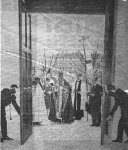
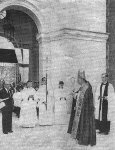
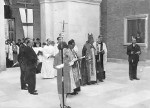 The
church was rededicated on 26 April 1964 by the Bishop of London, the Rt
Revd Dr Robert Stopford, before a congregation of 450. In his address he said - perhaps somewhat over-simplifying the issues, since the glory of God was not the only motive for the original building -The
Christian knows that no building can really be worthy to be the house
of God ... Whether it be a little church in a village or a great and
glorious cathedral the purpose is the same - to express our reverence
of God. Two-and-a-half centuries ago an architect of genius built three
great churches in East London - churches which I suspect even in the
day in which they were built were criticized as being too big and too
elaborate. But Hawksmoor was building for the glory of God. This
church served the worship of God for two-and-a-half centuries until the
war destroyed it, and now we thank God it has been restored. The
crucifer on this occasion was Brian Hill, and the servers Percy [aka
Richard] Chance (left) and John Hines (right). Percy was the sacristan,
and his wife Irene [Rene] made some of the altar linen. He died in 1993
(his funeral was at the church) and Rene in September 2015. Thanks
to Paul Chance for this information. He also was a server and acolyte,
and married Carole here in 1978; they returned for the
50th anniversary of the rededication.
The
church was rededicated on 26 April 1964 by the Bishop of London, the Rt
Revd Dr Robert Stopford, before a congregation of 450. In his address he said - perhaps somewhat over-simplifying the issues, since the glory of God was not the only motive for the original building -The
Christian knows that no building can really be worthy to be the house
of God ... Whether it be a little church in a village or a great and
glorious cathedral the purpose is the same - to express our reverence
of God. Two-and-a-half centuries ago an architect of genius built three
great churches in East London - churches which I suspect even in the
day in which they were built were criticized as being too big and too
elaborate. But Hawksmoor was building for the glory of God. This
church served the worship of God for two-and-a-half centuries until the
war destroyed it, and now we thank God it has been restored. The
crucifer on this occasion was Brian Hill, and the servers Percy [aka
Richard] Chance (left) and John Hines (right). Percy was the sacristan,
and his wife Irene [Rene] made some of the altar linen. He died in 1993
(his funeral was at the church) and Rene in September 2015. Thanks
to Paul Chance for this information. He also was a server and acolyte,
and married Carole here in 1978; they returned for the
50th anniversary of the rededication.
The Rectory was located in the
church, on two floors, and the parsonage house became 'The Old
Rectory', let out to various tenants. (It has now been restored to its
original use.) Here and here are
details of some events in the new crypt hall, and
in and around the church.
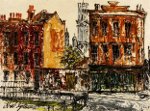 Around this time the Brotherhood of
Prayer and Action
had established a house at 220 Cable Street and participated in parish life.
Originally known as the ICF [Industrial Christian Fellowship]
Brotherhood of St George, this was a small lay community of working
men, single and
married,
founded in 1960 and centred on St George's House Wolverhampton with
branches elsewhere. They offered a 'ministry of concern', sharing their
homes with those in need of hospitality. Some of them worked with
homless meths drinkers at St Botolph's crypt. When on church business,
they
wore a cassock with a green girdle, and at other times their 'Chi-Rho'
brotherhood emblem. Arthur Greenwood (with a strong Brummie accent!), Frank Berry and Richard Smith were key members: see here for the corona lucis above the font which they designed and made. There is more detail about the Brotherhood in Peter Anson The Call of the Cloister (SPCK 1964) p219, and Anton Wallach-Clifford writes about their work at St Botolph's Crypt in No Fixed Abode (Macmillan 1974). Right is a 1970s oil painting by Noel Gibson of the church from Cable Street.
Around this time the Brotherhood of
Prayer and Action
had established a house at 220 Cable Street and participated in parish life.
Originally known as the ICF [Industrial Christian Fellowship]
Brotherhood of St George, this was a small lay community of working
men, single and
married,
founded in 1960 and centred on St George's House Wolverhampton with
branches elsewhere. They offered a 'ministry of concern', sharing their
homes with those in need of hospitality. Some of them worked with
homless meths drinkers at St Botolph's crypt. When on church business,
they
wore a cassock with a green girdle, and at other times their 'Chi-Rho'
brotherhood emblem. Arthur Greenwood (with a strong Brummie accent!), Frank Berry and Richard Smith were key members: see here for the corona lucis above the font which they designed and made. There is more detail about the Brotherhood in Peter Anson The Call of the Cloister (SPCK 1964) p219, and Anton Wallach-Clifford writes about their work at St Botolph's Crypt in No Fixed Abode (Macmillan 1974). Right is a 1970s oil painting by Noel Gibson of the church from Cable Street.
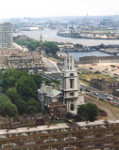 In 1971 St George's took on responsibility for St Paul Dock Street (which had previously incorporated St Mark Whitechapel
when this closed in 1925); worship continued there until 1990, when the
parish name changed from 'St George-in-the-East with Christ Church and
St John' to 'St George-in-the-East with St Paul'.
With all our daughter churches gone (except for St Mary Cable Street
and St Peter London Docks, which remained as separate parishes) we had
come full circle. Left - a view from 1977.
In 1971 St George's took on responsibility for St Paul Dock Street (which had previously incorporated St Mark Whitechapel
when this closed in 1925); worship continued there until 1990, when the
parish name changed from 'St George-in-the-East with Christ Church and
St John' to 'St George-in-the-East with St Paul'.
With all our daughter churches gone (except for St Mary Cable Street
and St Peter London Docks, which remained as separate parishes) we had
come full circle. Left - a view from 1977.
Details of the clergy who served the parish during the 20th
century and beyond are here. See here
for a 1971 letter sent to the parish by Gonville ffrench-Beytagh, Dean
of Johannesberg convicted for offences against the apartheid regime in
South Africa.
INTO THE
TWENTY-FIRST
CENTURY
A
changing parish

 The
parish, like the church, has been massively rebuilt, and social change
continues apace. [Left: panorama looking north from the tower; right a night sky]
The
parish, like the church, has been massively rebuilt, and social change
continues apace. [Left: panorama looking north from the tower; right a night sky]
- Alongside former Jewish, Maltese, north African and
European neighbours we now share the area with Bengalis, mostly from
the Sylhet region, who make up the majority population. Here
are some details of local mosques and Islamic centres.
- St George's Estate was built in the 1960's, with three tower blocks
added
a few years later. It is currently undergoing internal and external
refurbishment, 'cross-subsidised' by building additional blocks around the site.
- Docklands
and the 'City Quarter' have brought
up-market housing cheek-by-jowl with the estates. Many new blocks have been built, and there
are currently major development proposals for Goodman's Fields, the Royal Mint Street goods station site
- Along The Highway permission has been given for a hotel development opposite the church, and the News International (former printworks, and office spaces) will be re-developed.
-
Among the local gangs are (or were - the scene changes rapidly!) the Cannon Street Posse and Shadwell Massive
(around Solander Gardens).
-
The British
Film Institute Mediatheque
publishes a detailed guide to films in the East End Past and Present -
including several mentioned on these pages, set in this parish.
- See here for some details of public transport in and about the parish.
'The
King's Highway' - various schemes of the 80's, 90's and 00's
There
are three separate Anglican parishes in close proximity along or
close
The
Highway - ourselves, St Paul Shadwell and St Mary Cable Street
- as well as St Peter London Docks a few hundred yards down
Wapping Lane. (The last two were founded from St
George-in-the-East.) In addition, as explained above, St George's had taken on responsibility for St Paul Dock Street.
The
viability, staffing and future use of these churches was extensively
considered in the 1980s, at which time we had no resident priest, but
shared Julian Scharf with St Paul Shadwell (from 1979-86); see here for details of the major Auschwitz exhibition of 1983 held in the crypt during in his time.The Stepney Area Pastoral
Committee conducted a review of the pastoral provision for all the parishes south of the Commercial Road. As required under the 1983 Pastoral Measure
when re-organisation is in prospect, a report from
the Council for the Care of Churches [now Church Buildings Council], a
report was made on the architectural and aesthetic significance
of St George's (PM 1298 - this and many other documents from this
period are held at the Church
of England Record Centre
in Bermondsey). Unsurprisingly, this concluded that St George's
is a building of international significance, adding that the 1960s
interventions were a worthy example of the
'solutions' of that period.
In
late 1985 the Committee produced a report which recommended declaring St George-in-the-East redundant and developing it
for housing, shifting worship elsewhere: to St Paul Shadwell (also a
listed building,
but then in poor condition), St Paul Dock Street
(undistinguished, and also in poor condition), or St Mary Cable Street
(with the idea that this church, of lesser architectural significance
and likely to require major work in the future, might be rebuilt); they
also mooted building a new multi-purpose church in the area of
Wellclose Square, or on the former site of St John Golding Street. See here for the text of the report and parish and other responses. In the event, a further consultation was held,
and
a working party set up, with a
mixture of national experts (such as Dr Julian Litten) and members
of the parish (including Leo Aylen), and chaired by Peter Burman, the Secretary of the
Council for the Care of Churches - a sign of the importance of the
building. This concluded that worship should continue
at St George's, alongside the development of some major alternative
use, for
which various proposals were discussed, including
- a craft workshop (to
be a base for traditional skills needed for church restoration and
maintenance)
- a centre for religious history
- an art centre (with or
without a focus on 'sacred art')
- a community theatre base.
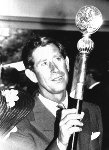 In 1988 a resident incumbent, Gillean Craig, was once again appointed, and set about rebuilding parish life. In due course, through his musical contacts
the Guildhall Ensemble,
the postgraduate arm of the Performance and
Skills Department of the Guildhall School of Music and Drama, working
to promote music in schools, hospitals, prisons and the local
community, made its base in the crypt ten years later. In 1989
ambitious plans by
architect Peter Renwick of Stanton Williams were prepared which would
have adapted the church to make a permanent home for the Ensemble,
leaving the 1960s worship space intact but creating a glazed atrium in
the courtyard to let light into the
crypt and provide public rooms, rehearsal space and galleries on four
levels. In 1991 a public appeal for £4m was launched by the Bishop of
Stepney and Lord Palumbo for a St George-in-the-East Centre - more about the scheme and the appeal here.
But, despite a visit from Prince Charles [right inspecting a warden's stave], the project failed to attract sufficient financial support, and ended in frustration.
In 1988 a resident incumbent, Gillean Craig, was once again appointed, and set about rebuilding parish life. In due course, through his musical contacts
the Guildhall Ensemble,
the postgraduate arm of the Performance and
Skills Department of the Guildhall School of Music and Drama, working
to promote music in schools, hospitals, prisons and the local
community, made its base in the crypt ten years later. In 1989
ambitious plans by
architect Peter Renwick of Stanton Williams were prepared which would
have adapted the church to make a permanent home for the Ensemble,
leaving the 1960s worship space intact but creating a glazed atrium in
the courtyard to let light into the
crypt and provide public rooms, rehearsal space and galleries on four
levels. In 1991 a public appeal for £4m was launched by the Bishop of
Stepney and Lord Palumbo for a St George-in-the-East Centre - more about the scheme and the appeal here.
But, despite a visit from Prince Charles [right inspecting a warden's stave], the project failed to attract sufficient financial support, and ended in frustration.
Throughout
the decade both parish and diocese worked on a sustainable future for
the church and parish. The parish set up St George-in-the-East Trust to
promote development proposals, with some 'seedcorn' funding and a
development worker (Melanie Hall, replaced in 2001 when she became an
ordination candidate by Thrisa Haldar as project co-ordinator and
fundraiser). A six-month Task Group, with church, local community and
borough representatives, met in the first half of 1999 to clarify the
vision, and was succeeded by a Development Committee. When Gillean
Craig left St George's in
2002 - and St Paul Shadwell was also vacant - a further period of
questioning
followed, about future staffing in relation to the deanery as a
whole, and about best use of the various parish buildings, some of
them very large:
our church, crypt, Rectory and Church House, Wellclose Square; St
Paul's Church, crypt (which at that time housed a nursery school -
since relocated here - see below),
Institute and Rectory; and St Mary's church and hall (with a variety of community uses). The Bishop of
London, who had previously been Bishop of Stepney, so knew the area
well, made it clear that he was opposed to church closure - retreat is simply not an option - and
stressed that
each congregation should continue, maintaining their distinctive
traditions. They are diverse, both liturgically and in relation
to to women priests and bishops (which we strongly
support); working together depends on good relationships!
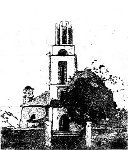
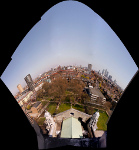 The
area, said Bishop Richard, has a distinguished history of Christian
service to the 'old' East End, and remains in touch with the dwindling but precious remnant of that old
world; but
the new facts are the rise of Islam
and the embourgisement of the Thames littoral. The
Highway - connecting the City with Docklands, and encompassing the new
immigrant communities as well as the new wealth - symbolises this
(though for all its symbolic significance it is somewhat off the beaten
track - hence the failure of Tobacco Dock, opposite the church, as a shopping centre).
The
area, said Bishop Richard, has a distinguished history of Christian
service to the 'old' East End, and remains in touch with the dwindling but precious remnant of that old
world; but
the new facts are the rise of Islam
and the embourgisement of the Thames littoral. The
Highway - connecting the City with Docklands, and encompassing the new
immigrant communities as well as the new wealth - symbolises this
(though for all its symbolic significance it is somewhat off the beaten
track - hence the failure of Tobacco Dock, opposite the church, as a shopping centre).
A
King's Highway working group
was set up, and detailed feasibility
studies done of all the available buildings. From this emerged
proposals for creating a 'Mission
Action Zone' (MAZ), bringing together these
three parishes - plus St Peter London Dock and St Dunstan Stepney which
are also part of the local 'cluster' of churches - and the Royal
Foundation of St Katharine. A great deal of energy was put into these
discussions. In
the event, and frustratingly, the MAZ also led nowhere. (Ironically, 41
years previously Fr Ken Leech, at that stage an ordinand who had
worked in the area for four years, proposed a scheme of collaborative
working in 'West Stepney' similar to the one envisaged for the MAZ,
which you can read here. Ken, now retired to his home town of Mossley in Lancashire, kept the golden jubilee of his ordination in 2014.)
Instead, in 2004 the bishop invited Holy Trinity Brompton
to plant a new
congregation (made up of HTB members from across
East London) at St Paul Shadwell; this began in January 2005, after
work on the church. This impacted in various ways on the other local
churches, unfortunately with limited consultation, and killed the MAZ
process.
'CRYPT EAST'


 A new focus emerged. East London provides an ideal context for ministerial education, for
clergy, Readers (Licensed Lay Ministers - LLMs) and others, and the North Thames Ministerial
Training Course
(NTMTC), in which London and Chelmsford dioceses are partners, needed a
new home, after a difficult history elsewhere. The Bishop of London's vision for a 'Christian
University
of the Highway', encompassing local parishes and also the Royal
Foundation of St Katharine
(which could have provided residential
accommodation for course weekends - though in the event did not), led
to a decision, primarily at his behest, to re-locate the administration
of the course to the eastern part of our crypt, which was converted at
considerable expense by the diocese (the parish being in vacancy at the
time), under a 25-year licence from the parish. The two dioceses made a
clear commitment to maintaining a teaching base in East London; and in
the event this space was used from 2005 not only for administration,
but also (though not planned with this in mind) for the weekly Tuesday
meetings - beginning
with a shared
meal in part of the nursery school and worship in the church, before
the teaching sessions for each of the three year groups. Also, from
2010, because of the course's declared and apparently firm
commitment to East London, the Stepney episcopal area worked hard
to bring its previously freestanding Reader (LLM) training under the
NTMTC 'umbrella' - so that candidates for lay and ordained ministry
could train together. Other areas of London diocese followed suit, with
varying degrees of commitment. Middlesex University validates the
academic components of the course's training (though the Bishop had hoped there might also be links with the
'archetypal'
church foundation of King's College London, which was formerly a centre for ordination training).
A new focus emerged. East London provides an ideal context for ministerial education, for
clergy, Readers (Licensed Lay Ministers - LLMs) and others, and the North Thames Ministerial
Training Course
(NTMTC), in which London and Chelmsford dioceses are partners, needed a
new home, after a difficult history elsewhere. The Bishop of London's vision for a 'Christian
University
of the Highway', encompassing local parishes and also the Royal
Foundation of St Katharine
(which could have provided residential
accommodation for course weekends - though in the event did not), led
to a decision, primarily at his behest, to re-locate the administration
of the course to the eastern part of our crypt, which was converted at
considerable expense by the diocese (the parish being in vacancy at the
time), under a 25-year licence from the parish. The two dioceses made a
clear commitment to maintaining a teaching base in East London; and in
the event this space was used from 2005 not only for administration,
but also (though not planned with this in mind) for the weekly Tuesday
meetings - beginning
with a shared
meal in part of the nursery school and worship in the church, before
the teaching sessions for each of the three year groups. Also, from
2010, because of the course's declared and apparently firm
commitment to East London, the Stepney episcopal area worked hard
to bring its previously freestanding Reader (LLM) training under the
NTMTC 'umbrella' - so that candidates for lay and ordained ministry
could train together. Other areas of London diocese followed suit, with
varying degrees of commitment. Middlesex University validates the
academic components of the course's training (though the Bishop had hoped there might also be links with the
'archetypal'
church foundation of King's College London, which was formerly a centre for ordination training).
In 2007, following the national recommendations for the setting up of
regional training partnerships to bring together all the providers in
each area, NTMTC became part of St Mellitus College,
with St Paul's Theological Centre (founded by Holy Trinity Brompton at
St Paul's Onslow Square) as their major partner, along with other local
courses. 'Generous orthodoxy' was the keyword.There were positive and
practical reasons for this merger, though it was important that NTMTC
should retain its own identity, as a course straddling all church
traditions, and with an open and flexible style of teaching. However,
with the financial pressures on ordination training (including the
withdrawal of government funding for vocational courses) the decision
was made that - despite the former commitment to East London - the
College would no longer maintain a base here once all administration
and teaching facilities moved to St Jude Courtfield Gardens in West
Kensington (a redundant church adapted by Holy Trinity Brompton to be
the centre for all St Mellitus activities). So in July 2012 the course
moved out - see the newsletter of that month for further comments, and for an explanation of the temporary occupation of this space by Wapping High School.
'CRYPT WEST'

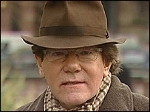 In 2006 Green Gables Montessori Nursery School
moved from
the crypt at St Paul Shadwell to the western end of the crypt at St George's,
the conversion work funded by the sale of Church House,
Wellclose Square to the diocese. (This remains boarded and undeveloped,
following the eviction of a community artists' squat, but we hope the
diocese will soon find new tenants.) Maxwell Hutchinson Studios were
the architects, working in close collaboration with the parish; Maxwell Hutchinson [right] is
a well-known broadcaster, writer and visiting professor, and a friend
of St George's, who preached here at an anniversary service; he was ordained to the permanent diaconate in 2014 [far right], and wrote in Church Times of 19 Dember 2014 about his and his wife's experience of being present at the tsunami ten years ago.
In 2006 Green Gables Montessori Nursery School
moved from
the crypt at St Paul Shadwell to the western end of the crypt at St George's,
the conversion work funded by the sale of Church House,
Wellclose Square to the diocese. (This remains boarded and undeveloped,
following the eviction of a community artists' squat, but we hope the
diocese will soon find new tenants.) Maxwell Hutchinson Studios were
the architects, working in close collaboration with the parish; Maxwell Hutchinson [right] is
a well-known broadcaster, writer and visiting professor, and a friend
of St George's, who preached here at an anniversary service; he was ordained to the permanent diaconate in 2014 [far right], and wrote in Church Times of 19 Dember 2014 about his and his wife's experience of being present at the tsunami ten years ago.
Church
and Rectory
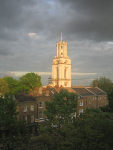 [Left in 2004, picture by John Bell]: as explained above, the crypt
now houses a variety of other users.
We
are looking hard at how we should best use the rest of
our rather complicated building to further the mission of the church
and serve our
community, responding to the ever-changing scene. We now have two good
meeting rooms, each with access to kitchen and
toilet facilities, available for a variety of uses.
[Left in 2004, picture by John Bell]: as explained above, the crypt
now houses a variety of other users.
We
are looking hard at how we should best use the rest of
our rather complicated building to further the mission of the church
and serve our
community, responding to the ever-changing scene. We now have two good
meeting rooms, each with access to kitchen and
toilet facilities, available for a variety of uses.
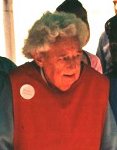
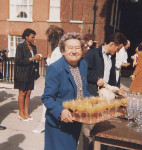 When Gillean Graig was Rector, he restored the Rectory, with English Heritage funding: more detail and drawings here. Victorian additions were removed and it became once
more the finest classical parsonage house in London. In the basement
flat lived Edith
Wyeth (pictured), whose home for nearly all her life was around the church site (she was baptized here in
1924); she and her husband were the churchwardens when the new church was consecrated.
In recognition of her lifelong service to the parish, the Bishop of
London made her a member of the Order
of St Mellitus in 2007. St
Mellitus (d.624) was the first Bishop of London, and third
Archbishop of Canterbury.
Canon Michael Saward (1932-2015), who in retirement was a member of our congregation for some years, when he lived locally, wrote this hymn about
him, originally sung at St Paul's Cathedral where he was on its staff.
Edith stood down as warden in 2009 after over 50 years of
service, but remained closely involved in all aspects of parish life
right up to her death, at the age of 87, in March 2011.
She maintained contact with an astonishing number of people from the
past, but was also full of hopes and dreams for the future. We pray
that her own future with the God whom she served so faithfully all her
life will bring her peace and joy! See the address at her funeral here.
When Gillean Graig was Rector, he restored the Rectory, with English Heritage funding: more detail and drawings here. Victorian additions were removed and it became once
more the finest classical parsonage house in London. In the basement
flat lived Edith
Wyeth (pictured), whose home for nearly all her life was around the church site (she was baptized here in
1924); she and her husband were the churchwardens when the new church was consecrated.
In recognition of her lifelong service to the parish, the Bishop of
London made her a member of the Order
of St Mellitus in 2007. St
Mellitus (d.624) was the first Bishop of London, and third
Archbishop of Canterbury.
Canon Michael Saward (1932-2015), who in retirement was a member of our congregation for some years, when he lived locally, wrote this hymn about
him, originally sung at St Paul's Cathedral where he was on its staff.
Edith stood down as warden in 2009 after over 50 years of
service, but remained closely involved in all aspects of parish life
right up to her death, at the age of 87, in March 2011.
She maintained contact with an astonishing number of people from the
past, but was also full of hopes and dreams for the future. We pray
that her own future with the God whom she served so faithfully all her
life will bring her peace and joy! See the address at her funeral here.
So a good
text for us to take with us into God's future for the parish
is Matthew 13.52 (REB):
|
Jesus
said, When a teacher of the law has become a learner in the kingdom of
Heaven,
he
is like a householder who can produce
from his store things
new and old.
|
Homepage | About Us | Services & Events
| Church &
Churchyard |
History
Newsletters & Sermons | Contacts,
Links & Registers | Giving | Picture
Gallery |
Site Map




 Note
that down
the years many street names have changed. The first major renaming
scheme was started in 1857 by
the Metropolitan Board of Works, encouraged by the General Post
Office, after the MBW was established by the Metropolis Management Act
of 1855 (postal districts were introduced in the following year).
Another took place in the 1890's, after the London County Council was
formed, and the next
big scheme occurred between 1929-45. Streets were often re-named after
local 'worthies', whose stories are told on the various history pages.
Click right for street lists of 1913, 1919 and 1923. See here for details of a few sites on the western edge which now fall within the City of London, rather than Tower Hamlets.
Note
that down
the years many street names have changed. The first major renaming
scheme was started in 1857 by
the Metropolitan Board of Works, encouraged by the General Post
Office, after the MBW was established by the Metropolis Management Act
of 1855 (postal districts were introduced in the following year).
Another took place in the 1890's, after the London County Council was
formed, and the next
big scheme occurred between 1929-45. Streets were often re-named after
local 'worthies', whose stories are told on the various history pages.
Click right for street lists of 1913, 1919 and 1923. See here for details of a few sites on the western edge which now fall within the City of London, rather than Tower Hamlets. After
Queen Anne came to the throne (1702-14), under the terms of the Acts of
Settlement designed to ensure the Protestant succession, and the Tories
took power after 22 years of Whig rule, a New
Churches in London &
Westminster Act
of 1710/1711 was passed, establishing a Commission to build fifty new
churches in populous districts. [See here for details of a 2011 Walk which marked its 300th anniversary.] The agenda was as much political as
pious: imposing edifices towering
over the homes of the working classes as a sign of the national religion -
especially needed, it was believed, in the East End where immigration
was taking hold and there were many dissenting conventicles. (This is
why episcopal mitres feature in the decoration of the apse, and no doubt why the dedication to St George was chosen.) They were
to be funded from a tax on coal and culm (a form of anthracite) - in theory, an infinite budget, but
only twelve (including St George-in-the-East) were ever completed. All
ran way over budget, and the scheme came to an end. There is much more
about
the architectural rationale, and Nicholas Hawksmoor the architect of
six of these churches, on
the Church & Churchyard page.
After
Queen Anne came to the throne (1702-14), under the terms of the Acts of
Settlement designed to ensure the Protestant succession, and the Tories
took power after 22 years of Whig rule, a New
Churches in London &
Westminster Act
of 1710/1711 was passed, establishing a Commission to build fifty new
churches in populous districts. [See here for details of a 2011 Walk which marked its 300th anniversary.] The agenda was as much political as
pious: imposing edifices towering
over the homes of the working classes as a sign of the national religion -
especially needed, it was believed, in the East End where immigration
was taking hold and there were many dissenting conventicles. (This is
why episcopal mitres feature in the decoration of the apse, and no doubt why the dedication to St George was chosen.) They were
to be funded from a tax on coal and culm (a form of anthracite) - in theory, an infinite budget, but
only twelve (including St George-in-the-East) were ever completed. All
ran way over budget, and the scheme came to an end. There is much more
about
the architectural rationale, and Nicholas Hawksmoor the architect of
six of these churches, on
the Church & Churchyard page.
 When
the church was consecrated on 19 July 1729, parts of 'Wapping-Stepney' were still
semi-rural, with open fields, but the area was beginning to develop. Right is
Roque's map of 1746.
Merchants who were building houses nearby, or came from further afield,
attended church in their
carriages (in 1739 only seven of the 2484 inhabitants of London that
'kept
coaches' lived in the parish), and access into the church was socially
segregated. The
local trades were ship-rigging and rope-making, of which
names like Cable Street and Ropewalk Gardens are a reminder - Cable
Street was once the length of the standard cable measure, 600 feet
[180m], with a ropewalk directly to the north of the church. From the
middle of the century hovels appeared in the marshlands behind
Pennington Street, which soon became wholly built over. By 1780 there
were 300 houses; by 1800, an average of 500-600 baptisms (rising
to over 1,000 two decades later, before daughter churches were built),
and
400-600
burials a year. The parish in those days extended down to the river:
the old parish of St John Wapping only covered a small area. In 1766 a
committee drawn from both parishes met to determine a procedure for
settling any disputes over 'bounds and boundaries'.
When
the church was consecrated on 19 July 1729, parts of 'Wapping-Stepney' were still
semi-rural, with open fields, but the area was beginning to develop. Right is
Roque's map of 1746.
Merchants who were building houses nearby, or came from further afield,
attended church in their
carriages (in 1739 only seven of the 2484 inhabitants of London that
'kept
coaches' lived in the parish), and access into the church was socially
segregated. The
local trades were ship-rigging and rope-making, of which
names like Cable Street and Ropewalk Gardens are a reminder - Cable
Street was once the length of the standard cable measure, 600 feet
[180m], with a ropewalk directly to the north of the church. From the
middle of the century hovels appeared in the marshlands behind
Pennington Street, which soon became wholly built over. By 1780 there
were 300 houses; by 1800, an average of 500-600 baptisms (rising
to over 1,000 two decades later, before daughter churches were built),
and
400-600
burials a year. The parish in those days extended down to the river:
the old parish of St John Wapping only covered a small area. In 1766 a
committee drawn from both parishes met to determine a procedure for
settling any disputes over 'bounds and boundaries'. As
with some other new East London parishes of this period, St
George-in-the-East, though within the diocese of London, was exempt
from the jurisdiction of any archdeacon, and this anomaly remained into
the 19th century. The Vestry combined ecclesiastical and local
government responsibilities, and was 'general' (as opposed to 'select',
as elsewhere), open to all who paid 2s. or more per month for poor relief. Robert Seymour's 1835 Survey of the Cities of London & Westminster
- a part-published update of the work of the Elizabethan chronicler
John Stow - gives details of the officers it continued to appoint: 2
Churchwardens and 4 Overseers (the senior 'parish officers') and - from the lower
and middling ranks of society - 1 Constable, 13 Headboroughs (subordinates to the Constable, responsible for law enforcement), 4
Scavengers (responsible for keeping the streets clean), and 2 Surveyors
of the Highway ('peace officers'). As explained here, men were sometimes elected as
councilmen and aldermen who did not wish to serve for business or
religious reasons, in which case they could pay a fine to be exempted. The
parish was divided into two divisions, the upper and lower town
(Seymour lists the streets in each). Edward Scott was elected
Scavenger for the upper division of the parish in 1732, and Thomas
Saunders of the lower division in 1748. Left is
a challenge of 1754 on the regularity of the appointment of the
overseers of the poor, and on their assessments (claiming that the
well-to-do have been undercharged and the less affluent overcharged) -
a transcript can be read here. The first parish clerk was Samuel Bright, formerly a barber and periwig-maker: the Vestry determined that this should be a full-time post. His successor was Thomas Harmer Lacon (buried in a vault in the crypt in 1821, aged 65). Both of them frequently signed as witnesses in the marriage registers. See here for an account of the dismissal of Joseph Mee as grave-digger and bell-ringer in 1766. (Seymour also noted that 'Prayers are held on Wednesdays, Fridays, and Holidays [sic] about 11 o'clock, no Organ [but see above], one Bell'.)
As
with some other new East London parishes of this period, St
George-in-the-East, though within the diocese of London, was exempt
from the jurisdiction of any archdeacon, and this anomaly remained into
the 19th century. The Vestry combined ecclesiastical and local
government responsibilities, and was 'general' (as opposed to 'select',
as elsewhere), open to all who paid 2s. or more per month for poor relief. Robert Seymour's 1835 Survey of the Cities of London & Westminster
- a part-published update of the work of the Elizabethan chronicler
John Stow - gives details of the officers it continued to appoint: 2
Churchwardens and 4 Overseers (the senior 'parish officers') and - from the lower
and middling ranks of society - 1 Constable, 13 Headboroughs (subordinates to the Constable, responsible for law enforcement), 4
Scavengers (responsible for keeping the streets clean), and 2 Surveyors
of the Highway ('peace officers'). As explained here, men were sometimes elected as
councilmen and aldermen who did not wish to serve for business or
religious reasons, in which case they could pay a fine to be exempted. The
parish was divided into two divisions, the upper and lower town
(Seymour lists the streets in each). Edward Scott was elected
Scavenger for the upper division of the parish in 1732, and Thomas
Saunders of the lower division in 1748. Left is
a challenge of 1754 on the regularity of the appointment of the
overseers of the poor, and on their assessments (claiming that the
well-to-do have been undercharged and the less affluent overcharged) -
a transcript can be read here. The first parish clerk was Samuel Bright, formerly a barber and periwig-maker: the Vestry determined that this should be a full-time post. His successor was Thomas Harmer Lacon (buried in a vault in the crypt in 1821, aged 65). Both of them frequently signed as witnesses in the marriage registers. See here for an account of the dismissal of Joseph Mee as grave-digger and bell-ringer in 1766. (Seymour also noted that 'Prayers are held on Wednesdays, Fridays, and Holidays [sic] about 11 o'clock, no Organ [but see above], one Bell'.) There were two
early medical charities
(unconnected with the church, though see here for an example of the involvement of a churchwarden with these two institutions, and with the emerging London Hospital - right in 1740s, with St George-in-the-East in the background:
There were two
early medical charities
(unconnected with the church, though see here for an example of the involvement of a churchwarden with these two institutions, and with the emerging London Hospital - right in 1740s, with St George-in-the-East in the background: A 1796 Act of Parliament required annual training, under the direction of the Constable of the Tower, of a regiment of the Tower Hamlets Militia (whose origins lay in the pre-Civil War 'Trayned Bandes'
to protect the Tower, taking the name of Tower Hamlets in 1605). The
Vestry objected (unsuccessfully) to the number called up - it was done
by ballot, with a quota from each of the Hamlets - complaining that
many inhabitants were ineligible, being seafaring persons, free watermen, labouring men with infirmities, and
undersized (particularly in the weaving manufactories), foreigners and
other exempted persons.
A further Act of 1813 extended their service liability to all parts of
the kingdom, and removed a previous anomaly which expressly excluded TH
militiamen's families from financial relief. The following year 25 men
served in the Waterloo campaign with the 3/14th Regiment of Foot ('A very Pretty Little Battalion').The First Regiment had its own March and Quickstep, by William Liquorish (a relative of Thomas Liquorish,
who had served with the Militia prior to serving as churchwarden),
published in 1796 in full score for regimental band and in piano
adaptation. [Shoulder belt plate from this period right - these were abolished in 1855.] The Militia office was in Wellclose Square.
A 1796 Act of Parliament required annual training, under the direction of the Constable of the Tower, of a regiment of the Tower Hamlets Militia (whose origins lay in the pre-Civil War 'Trayned Bandes'
to protect the Tower, taking the name of Tower Hamlets in 1605). The
Vestry objected (unsuccessfully) to the number called up - it was done
by ballot, with a quota from each of the Hamlets - complaining that
many inhabitants were ineligible, being seafaring persons, free watermen, labouring men with infirmities, and
undersized (particularly in the weaving manufactories), foreigners and
other exempted persons.
A further Act of 1813 extended their service liability to all parts of
the kingdom, and removed a previous anomaly which expressly excluded TH
militiamen's families from financial relief. The following year 25 men
served in the Waterloo campaign with the 3/14th Regiment of Foot ('A very Pretty Little Battalion').The First Regiment had its own March and Quickstep, by William Liquorish (a relative of Thomas Liquorish,
who had served with the Militia prior to serving as churchwarden),
published in 1796 in full score for regimental band and in piano
adaptation. [Shoulder belt plate from this period right - these were abolished in 1855.] The Militia office was in Wellclose Square.


 In
1844 the Association for Promoting
Cleanliness among the Poor
built baths and a laundry for the 'destitute poor'
in
Glasshouse Yard [now John Fisher Street], which was used by 27,662
bathers and 35,480 washers in
its first year. Bathers and washers paid one penny, ironers a farthing.
The Association also provided whitewash, and lent buckets and pails.
Its success led to an Act of Parliament in 1846 'To encourage the
Establishment
of Baths and Wash-houses', funded from the rates. See here
for the major part that William
Quekett, Lecturer and Curate of the parish, played in this - against initial opposition from the parish vestry - arguing that it was both philanthropic and would in the long term bring
savings to ratepayers [1846 handbill right]. In Curiosities of London: Exhibiting the Most Rare and Remarkable (1855), p33, John Timbs opined ...
so strong was the love of cleanliness thus encouraged that women often
toiled to wash their own and their children's clothing, who had been
compelled to sell their hair to purchase food to satisfy the cravings
of hunger. However, in 1850 the Vestry passed a resolution
objecting to the establishment of further facilities in the parish.
In
1844 the Association for Promoting
Cleanliness among the Poor
built baths and a laundry for the 'destitute poor'
in
Glasshouse Yard [now John Fisher Street], which was used by 27,662
bathers and 35,480 washers in
its first year. Bathers and washers paid one penny, ironers a farthing.
The Association also provided whitewash, and lent buckets and pails.
Its success led to an Act of Parliament in 1846 'To encourage the
Establishment
of Baths and Wash-houses', funded from the rates. See here
for the major part that William
Quekett, Lecturer and Curate of the parish, played in this - against initial opposition from the parish vestry - arguing that it was both philanthropic and would in the long term bring
savings to ratepayers [1846 handbill right]. In Curiosities of London: Exhibiting the Most Rare and Remarkable (1855), p33, John Timbs opined ...
so strong was the love of cleanliness thus encouraged that women often
toiled to wash their own and their children's clothing, who had been
compelled to sell their hair to purchase food to satisfy the cravings
of hunger. However, in 1850 the Vestry passed a resolution
objecting to the establishment of further facilities in the parish.

 The main authority was the
Public Vestry,
elected each Easter by ratepayers. Sir Benjamin
Hall's Metropolis
Management Act of
1855 swept these away and created a Select
Vestry
(chaired by the
incumbent) and Boards for each parish. See here
for more details of this 'incorporation', in a restrospective paper of 1880 by the Vestry Clerk. (It also created the Metropolitan Board of Works - see here for details of its first clerk, later a local police court judge.) In 1856 the High Court dealt
with a dispute between the new Vestry and London Docks over the rate
levied on the Docks for street paving. It took over responsibility for
the local section of the Commercial Road when tolls were abolished in
1865. There was continued scope for electoral corruption where voters
were illiterate - left
is a completed voting paper for the 1862 vestry, together with lists of
parish officers for 1866 and 1871 (note the change from 'Vestrymen' to
'Guardians of the Poor'). More details of many of these men are given here. The clerk - usually full-time, and often a solicitor (as with W.L. Howell,
in post at the time of the Ritualism Riots; he was also the Registrar
for one of the sub-districts of Gt George's East) - was a key
person. Salaries for this post varied widely, depending on local
history and the energy and contacts of the postholder;
here he was paid £500 but had to pay his staff from this (as did his
counterparts at Bethnal Green, on £750, and St Luke Old Street, on
£800).
The main authority was the
Public Vestry,
elected each Easter by ratepayers. Sir Benjamin
Hall's Metropolis
Management Act of
1855 swept these away and created a Select
Vestry
(chaired by the
incumbent) and Boards for each parish. See here
for more details of this 'incorporation', in a restrospective paper of 1880 by the Vestry Clerk. (It also created the Metropolitan Board of Works - see here for details of its first clerk, later a local police court judge.) In 1856 the High Court dealt
with a dispute between the new Vestry and London Docks over the rate
levied on the Docks for street paving. It took over responsibility for
the local section of the Commercial Road when tolls were abolished in
1865. There was continued scope for electoral corruption where voters
were illiterate - left
is a completed voting paper for the 1862 vestry, together with lists of
parish officers for 1866 and 1871 (note the change from 'Vestrymen' to
'Guardians of the Poor'). More details of many of these men are given here. The clerk - usually full-time, and often a solicitor (as with W.L. Howell,
in post at the time of the Ritualism Riots; he was also the Registrar
for one of the sub-districts of Gt George's East) - was a key
person. Salaries for this post varied widely, depending on local
history and the energy and contacts of the postholder;
here he was paid £500 but had to pay his staff from this (as did his
counterparts at Bethnal Green, on £750, and St Luke Old Street, on
£800). 

 St George's Town Hall
on Cable Street was originally the Vestry Hall, built in 1861 at a cost of
£6,000. (Prior to this the Vestry met in a room on the south-west corner of the church.) Left are
details of contracts entered into by the Vestry in 1862 and 1864 for
public works, including street lighting, 'cleansing and watering' the
streets and 'removal of dust', paving and sewerage, and work on the
Vestry Hall. See here
for the story of William Cooke, one of the three parish rate
collectors in 1866, who held various other offices in the parish in his
time, and was also an undertaker. Right is a ticket for a dinner held there in 1874 to mark the Duke of
Edinburgh's marriage. [The
1899 London
Government Act
replaced Vestries with 28 Borough Councils,
when the new Stepney Borough
Council took over the building as a local Town Hall; since the creation
of the London Borough of Tower Hamlets in 1963 it is now used for
a variety of local projects.] Some local streets bear vestry members' names: for
example, Fairclough [formerly North], Dellow [formerly Victoria] and Stutfield [formerly Elizabeth] Streets.
St George's Town Hall
on Cable Street was originally the Vestry Hall, built in 1861 at a cost of
£6,000. (Prior to this the Vestry met in a room on the south-west corner of the church.) Left are
details of contracts entered into by the Vestry in 1862 and 1864 for
public works, including street lighting, 'cleansing and watering' the
streets and 'removal of dust', paving and sewerage, and work on the
Vestry Hall. See here
for the story of William Cooke, one of the three parish rate
collectors in 1866, who held various other offices in the parish in his
time, and was also an undertaker. Right is a ticket for a dinner held there in 1874 to mark the Duke of
Edinburgh's marriage. [The
1899 London
Government Act
replaced Vestries with 28 Borough Councils,
when the new Stepney Borough
Council took over the building as a local Town Hall; since the creation
of the London Borough of Tower Hamlets in 1963 it is now used for
a variety of local projects.] Some local streets bear vestry members' names: for
example, Fairclough [formerly North], Dellow [formerly Victoria] and Stutfield [formerly Elizabeth] Streets.


 The St George-in-the-East
Vestry was among a number of local authorities that, for various
reasons, made limited use of these powers. However, see here
for the Rector's delight at the condemning of over 200 of properties by
our Medical Officer of Health immediately after the passage of the 1875
Act; here for details of the Whitechapel Estate, a major '5% philanthropy' scheme
just outside the civil parish (and now within the ecclesiastical
parish), promoted by the Metropolitan
Board of Works and the Peabody Trust; and here
for the adjacent Katharine Buildings project in Cartwright Street,
creating housing for those beyond the reach of
other providers. The legislation was consolidated
as Parts I and II of the 1890
Housing of the Working Classes Act.
The St George-in-the-East
Vestry was among a number of local authorities that, for various
reasons, made limited use of these powers. However, see here
for the Rector's delight at the condemning of over 200 of properties by
our Medical Officer of Health immediately after the passage of the 1875
Act; here for details of the Whitechapel Estate, a major '5% philanthropy' scheme
just outside the civil parish (and now within the ecclesiastical
parish), promoted by the Metropolitan
Board of Works and the Peabody Trust; and here
for the adjacent Katharine Buildings project in Cartwright Street,
creating housing for those beyond the reach of
other providers. The legislation was consolidated
as Parts I and II of the 1890
Housing of the Working Classes Act. The age of district churches, and buildings
The age of district churches, and buildings By
1870, for the first time, the district was classed as one of the five
poorest in London. But the St George-in-the-East Poor Law Guardians
- like their counterparts in Stepney and Whitechapel - virtually ceased
making 'out-relief' payments (as opposed to
'in-relief' - the workhouses). This was partly because of the growing
influence of the Charity Organisation Society which
pressed for more targeted assistance.
By
1870, for the first time, the district was classed as one of the five
poorest in London. But the St George-in-the-East Poor Law Guardians
- like their counterparts in Stepney and Whitechapel - virtually ceased
making 'out-relief' payments (as opposed to
'in-relief' - the workhouses). This was partly because of the growing
influence of the Charity Organisation Society which
pressed for more targeted assistance. 


 In 1883 St George's Mission House
at 136 St George's Street [later renumbered 181 The Highway] was built at the cost of £5000
- a susbstantial building on three floors with acommodation
above. Goad's 1887 insurance map show that it had a wine store to
the left, and a colour works and chemical packaging company on the
right, and the whole area around the south and west of the church was
built up. The hall
was demolished after 1962, when The Highway was widened. You
can still see the headstone of the rear door in the wall by the church [pictured] - a separately-listed feature.
In 1883 St George's Mission House
at 136 St George's Street [later renumbered 181 The Highway] was built at the cost of £5000
- a susbstantial building on three floors with acommodation
above. Goad's 1887 insurance map show that it had a wine store to
the left, and a colour works and chemical packaging company on the
right, and the whole area around the south and west of the church was
built up. The hall
was demolished after 1962, when The Highway was widened. You
can still see the headstone of the rear door in the wall by the church [pictured] - a separately-listed feature. There was also a small parish room built on the north-west corner of
the Rectory, at some point before 1890 [plan of house and garden left] - when was it demolished?
There was also a small parish room built on the north-west corner of
the Rectory, at some point before 1890 [plan of house and garden left] - when was it demolished?
 As in many parishes, formal missions
were organised (though Harry Jones, Rector 1873-82, was not a fan - see why here).
In the major London-wide mission of 1884-5, the missioners appointed
for St George-in-the-East were the Revd W.M. Sinclair, Vicar of St
Stephen Westminster; for Christ Church, The Revd Wladislaw Somerville
Lach-Szyrma of St
Peter Newlyn, Penzance but later of Barkingside (his Polish father had
fled persecution and married into a naval family - several descendents
became Anglican clergy);
and for St John the Evangelist-in-the-East, The Rev E. Bickersteth,
Rector of Framlingham, and the Hon and Rev R. E. Adderley, Curate of
All Hallows Barking (both from famous clerical families, and
experienced mission speakers). [Right is the Advent programme for 1878, and an 1893 mission card.]
As in many parishes, formal missions
were organised (though Harry Jones, Rector 1873-82, was not a fan - see why here).
In the major London-wide mission of 1884-5, the missioners appointed
for St George-in-the-East were the Revd W.M. Sinclair, Vicar of St
Stephen Westminster; for Christ Church, The Revd Wladislaw Somerville
Lach-Szyrma of St
Peter Newlyn, Penzance but later of Barkingside (his Polish father had
fled persecution and married into a naval family - several descendents
became Anglican clergy);
and for St John the Evangelist-in-the-East, The Rev E. Bickersteth,
Rector of Framlingham, and the Hon and Rev R. E. Adderley, Curate of
All Hallows Barking (both from famous clerical families, and
experienced mission speakers). [Right is the Advent programme for 1878, and an 1893 mission card.] 

 The East London History
Society
enables you to compare a range of old and new maps
side-by-side and has many other excellent features. Maps which it
does not feature include that of Weller in 1868 [right], which clearly shows the
location of the churches, and the 1894 Ordnance Survey map of part of the parish [far right].
The East London History
Society
enables you to compare a range of old and new maps
side-by-side and has many other excellent features. Maps which it
does not feature include that of Weller in 1868 [right], which clearly shows the
location of the churches, and the 1894 Ordnance Survey map of part of the parish [far right].
 This interview with R.W. Harris
(Rector 1897-1903) in the Charles
Booth archive
[B222,
pages 150-179] details many of these parish organisations, and
reports
on the 'invalid kitchen', and the initiative of 'St
George-in-the-East Window Garden
Society' - a recognition that a windox box rather than a garden was the
closest many came to nature (see here for an 1865 initiative by the Royal Horticultural Society along these lines). In
1906 the winner of the annual
competition was the ten-year old Harry Sleight, who lived at 1 Redmead
Lane,
Wapping all his life until he was moved out by Docklands
redevelopment
in the late 1970s. He
was presented with an
inscribed silver pocket watch, which he treasured all his life, as does
his family - it is still in good working order (our thanks to his grandson Geoffrey for
these pictures).
This interview with R.W. Harris
(Rector 1897-1903) in the Charles
Booth archive
[B222,
pages 150-179] details many of these parish organisations, and
reports
on the 'invalid kitchen', and the initiative of 'St
George-in-the-East Window Garden
Society' - a recognition that a windox box rather than a garden was the
closest many came to nature (see here for an 1865 initiative by the Royal Horticultural Society along these lines). In
1906 the winner of the annual
competition was the ten-year old Harry Sleight, who lived at 1 Redmead
Lane,
Wapping all his life until he was moved out by Docklands
redevelopment
in the late 1970s. He
was presented with an
inscribed silver pocket watch, which he treasured all his life, as does
his family - it is still in good working order (our thanks to his grandson Geoffrey for
these pictures).




 A high point in the time of F. St. J. Corbett
(Rector 1903-19) was the visit on 14 July 1904 of Queen Alexandra, wife
of King Edward VII, for a flower show and sale of work (the fourth
picture shows the Victorian extension to the Rectory), which provided a
welcome fillip to parish finances. The circumstances of her visit are
recounted in press cuttings here and an interview here.
A high point in the time of F. St. J. Corbett
(Rector 1903-19) was the visit on 14 July 1904 of Queen Alexandra, wife
of King Edward VII, for a flower show and sale of work (the fourth
picture shows the Victorian extension to the Rectory), which provided a
welcome fillip to parish finances. The circumstances of her visit are
recounted in press cuttings here and an interview here.  Then
came the Great War.
Clergy left to serve as chaplains on the
front, or, like our own Rector [pictured - more details here] remained in their parishes while serving units on the home front. They discovered (though
those who had served in the East
End surely knew already) how tenuous were the links of soldiers with
the Christian
faith: the church needed to change. (See
Alan WilkinsonThe Church of England and the First World War SCM
1996). Our
churches struggled: particularly in the last two years of the war,
numbers of baptisms and weddings fell sharply. In the post-war years
various national initiatives to 're-connect' were made - for example,
the National Mission of Repentance
and Hope, first launched in 1916, with William Temple as its
secretary. It
was also the time of
massive expansion of council housing, to provide 'homes fit for heroes'
in new outer suburbs; the population became more mobile. And it
was a time when the way the Church of England conducted its
business changed, with the introduction of what we now call synodical
government: see here
for more details.
Then
came the Great War.
Clergy left to serve as chaplains on the
front, or, like our own Rector [pictured - more details here] remained in their parishes while serving units on the home front. They discovered (though
those who had served in the East
End surely knew already) how tenuous were the links of soldiers with
the Christian
faith: the church needed to change. (See
Alan WilkinsonThe Church of England and the First World War SCM
1996). Our
churches struggled: particularly in the last two years of the war,
numbers of baptisms and weddings fell sharply. In the post-war years
various national initiatives to 're-connect' were made - for example,
the National Mission of Repentance
and Hope, first launched in 1916, with William Temple as its
secretary. It
was also the time of
massive expansion of council housing, to provide 'homes fit for heroes'
in new outer suburbs; the population became more mobile. And it
was a time when the way the Church of England conducted its
business changed, with the introduction of what we now call synodical
government: see here
for more details.
 When
J.C. Pringle was appointed
Rector in 1919, although the range of
clubs and activities (particularly for girls) continued, with new ones
for children and adults added in the next few years,
congregational numbers remained low - see here for more
details. The bishop was not prepared to license a curate
to the parish; instead, a succession of licensed women workers was appointed.
Repairs to the church, including the installation of electric lighting
(partly funded by the sale by faculty of some historic church plate), delayed the installation of a war memorial until 1924 - see here for
details of the memorial, and the subsequent keeping of Armisticetide.
There is more about Pringle's ministry here,
and his connections with the Charity Organisation Society); and here
are some of his forthright, and often startling, opinions from the
parish magazine. Right
is a 1922 view of the docks, looking from the river towards the church,
and one of many images of local poverty from this period.
When
J.C. Pringle was appointed
Rector in 1919, although the range of
clubs and activities (particularly for girls) continued, with new ones
for children and adults added in the next few years,
congregational numbers remained low - see here for more
details. The bishop was not prepared to license a curate
to the parish; instead, a succession of licensed women workers was appointed.
Repairs to the church, including the installation of electric lighting
(partly funded by the sale by faculty of some historic church plate), delayed the installation of a war memorial until 1924 - see here for
details of the memorial, and the subsequent keeping of Armisticetide.
There is more about Pringle's ministry here,
and his connections with the Charity Organisation Society); and here
are some of his forthright, and often startling, opinions from the
parish magazine. Right
is a 1922 view of the docks, looking from the river towards the church,
and one of many images of local poverty from this period. Left
are Miss E K Palmer and Mr J Day, churchwardens for
1937. Miss Palmer had been Superintendent of the Sunday School for
many years, and a key figure in the parish. Female wardens were not
yet common in the Church of England - but we were becoming a
progressive parish! Their churchwardens' staves remain in use.
Left
are Miss E K Palmer and Mr J Day, churchwardens for
1937. Miss Palmer had been Superintendent of the Sunday School for
many years, and a key figure in the parish. Female wardens were not
yet common in the Church of England - but we were becoming a
progressive parish! Their churchwardens' staves remain in use.

 When the
Second World War began, clergy were again in short supply, and six
local parishes were grouped together; St John's was closed. On 16 April
1941 Christ Church
and its vicarage were destroyed by a landmine, and St George's was
gutted the next month. Writing of the bombing of the parish, the Communist councillor (and MP from 1945) Phil Piratin said We saw them coming over against the bright blue sky. A policeman said 'better get in'. Then the bombs began to drop. All remaining clergy, led by Fr John Groser
from
Christ Church,
moved to the
Rectory, where services were held in the living room [left today] - including a daily eucharist, without a break - until they moved into the
'Upper Room' of the Mission House the following year (some years later,
a service was held for the renewal of vows of those married there -
including Ros Rowley, with whom we are still in touch). Nora Neal also joined the team as a licensed lay worker during the war
years. From 1942 the crypt was used (by
faculty) as an air-raid shelter. Right is a map of the bombing across London - see also this interactive website - and a local aerial view from 1960. Ritchie Calder Carry On London! (English University Press 1941) contains many personal stories. See here for a peace party in Walburgh Street.
When the
Second World War began, clergy were again in short supply, and six
local parishes were grouped together; St John's was closed. On 16 April
1941 Christ Church
and its vicarage were destroyed by a landmine, and St George's was
gutted the next month. Writing of the bombing of the parish, the Communist councillor (and MP from 1945) Phil Piratin said We saw them coming over against the bright blue sky. A policeman said 'better get in'. Then the bombs began to drop. All remaining clergy, led by Fr John Groser
from
Christ Church,
moved to the
Rectory, where services were held in the living room [left today] - including a daily eucharist, without a break - until they moved into the
'Upper Room' of the Mission House the following year (some years later,
a service was held for the renewal of vows of those married there -
including Ros Rowley, with whom we are still in touch). Nora Neal also joined the team as a licensed lay worker during the war
years. From 1942 the crypt was used (by
faculty) as an air-raid shelter. Right is a map of the bombing across London - see also this interactive website - and a local aerial view from 1960. Ritchie Calder Carry On London! (English University Press 1941) contains many personal stories. See here for a peace party in Walburgh Street. 






 In December
1943 a prefab within the
shell of the church, 'St George-in-the-Ruins' - above left - became
the parish's home for the
next seventeen years. This leaflet circulated at the end of the War explains the pastoral
re-organisation of the parish, and the pattern of worship in what is
optimistically described as the charming little temporary church now built inside the roofless walls of the old church. By contrast, Prebendary Arthur Royall, a chronicler of East London Church life (who died in 2013), commented I
worshipped there one Sunday morning in the late 1940's and have vague
memories of what appeared, from the outside, to be a large shabby
wooden shed. Right is the first appeal for funds to rebuild the church.
In December
1943 a prefab within the
shell of the church, 'St George-in-the-Ruins' - above left - became
the parish's home for the
next seventeen years. This leaflet circulated at the end of the War explains the pastoral
re-organisation of the parish, and the pattern of worship in what is
optimistically described as the charming little temporary church now built inside the roofless walls of the old church. By contrast, Prebendary Arthur Royall, a chronicler of East London Church life (who died in 2013), commented I
worshipped there one Sunday morning in the late 1940's and have vague
memories of what appeared, from the outside, to be a large shabby
wooden shed. Right is the first appeal for funds to rebuild the church.


 In
1960, now with Fr Alex Solomon as Rector, the congregation
moved out of the prefab for the new church to
be constructed, and for 3¾ years they worshipped in the 'Upper Room' of
the old mission hall pictured left in 1960]. 686 coffins were moved out of the crypt and
reburied at
Brookwood
Cemetery [listed left]. The
detailed story of the whole process is told here
by Fr Solomon, and the new church is described in detail here; see also a 1959 architectural assessment [right]. The 1963 sketch by Paul Joyce shows the remains of building (including the Mission Hall) during the period of reconstruction.
In
1960, now with Fr Alex Solomon as Rector, the congregation
moved out of the prefab for the new church to
be constructed, and for 3¾ years they worshipped in the 'Upper Room' of
the old mission hall pictured left in 1960]. 686 coffins were moved out of the crypt and
reburied at
Brookwood
Cemetery [listed left]. The
detailed story of the whole process is told here
by Fr Solomon, and the new church is described in detail here; see also a 1959 architectural assessment [right]. The 1963 sketch by Paul Joyce shows the remains of building (including the Mission Hall) during the period of reconstruction.

 The
church was rededicated on 26 April 1964 by the Bishop of London, the Rt
Revd Dr Robert Stopford, before a congregation of 450. In his address he said - perhaps somewhat over-simplifying the issues, since the glory of God was not the only motive for the original building -The
Christian knows that no building can really be worthy to be the house
of God ... Whether it be a little church in a village or a great and
glorious cathedral the purpose is the same - to express our reverence
of God. Two-and-a-half centuries ago an architect of genius built three
great churches in East London - churches which I suspect even in the
day in which they were built were criticized as being too big and too
elaborate. But Hawksmoor was building for the glory of God. This
church served the worship of God for two-and-a-half centuries until the
war destroyed it, and now we thank God it has been restored. The
crucifer on this occasion was Brian Hill, and the servers Percy [aka
Richard] Chance (left) and John Hines (right). Percy was the sacristan,
and his wife Irene [Rene] made some of the altar linen. He died in 1993
(his funeral was at the church) and Rene in September 2015. Thanks
to Paul Chance for this information. He also was a server and acolyte,
and married Carole here in 1978; they returned for the
50th anniversary of the rededication.
The
church was rededicated on 26 April 1964 by the Bishop of London, the Rt
Revd Dr Robert Stopford, before a congregation of 450. In his address he said - perhaps somewhat over-simplifying the issues, since the glory of God was not the only motive for the original building -The
Christian knows that no building can really be worthy to be the house
of God ... Whether it be a little church in a village or a great and
glorious cathedral the purpose is the same - to express our reverence
of God. Two-and-a-half centuries ago an architect of genius built three
great churches in East London - churches which I suspect even in the
day in which they were built were criticized as being too big and too
elaborate. But Hawksmoor was building for the glory of God. This
church served the worship of God for two-and-a-half centuries until the
war destroyed it, and now we thank God it has been restored. The
crucifer on this occasion was Brian Hill, and the servers Percy [aka
Richard] Chance (left) and John Hines (right). Percy was the sacristan,
and his wife Irene [Rene] made some of the altar linen. He died in 1993
(his funeral was at the church) and Rene in September 2015. Thanks
to Paul Chance for this information. He also was a server and acolyte,
and married Carole here in 1978; they returned for the
50th anniversary of the rededication. Around this time the Brotherhood of
Prayer and Action
had established a house at 220 Cable Street and participated in parish life.
Originally known as the ICF [Industrial Christian Fellowship]
Brotherhood of St George, this was a small lay community of working
men, single and
married,
founded in 1960 and centred on St George's House Wolverhampton with
branches elsewhere. They offered a 'ministry of concern', sharing their
homes with those in need of hospitality. Some of them worked with
homless meths drinkers at St Botolph's crypt. When on church business,
they
wore a cassock with a green girdle, and at other times their 'Chi-Rho'
brotherhood emblem. Arthur Greenwood (with a strong Brummie accent!), Frank Berry and Richard Smith were key members: see here for the corona lucis above the font which they designed and made. There is more detail about the Brotherhood in Peter Anson The Call of the Cloister (SPCK 1964) p219, and Anton Wallach-Clifford writes about their work at St Botolph's Crypt in No Fixed Abode (Macmillan 1974). Right is a 1970s oil painting by Noel Gibson of the church from Cable Street.
Around this time the Brotherhood of
Prayer and Action
had established a house at 220 Cable Street and participated in parish life.
Originally known as the ICF [Industrial Christian Fellowship]
Brotherhood of St George, this was a small lay community of working
men, single and
married,
founded in 1960 and centred on St George's House Wolverhampton with
branches elsewhere. They offered a 'ministry of concern', sharing their
homes with those in need of hospitality. Some of them worked with
homless meths drinkers at St Botolph's crypt. When on church business,
they
wore a cassock with a green girdle, and at other times their 'Chi-Rho'
brotherhood emblem. Arthur Greenwood (with a strong Brummie accent!), Frank Berry and Richard Smith were key members: see here for the corona lucis above the font which they designed and made. There is more detail about the Brotherhood in Peter Anson The Call of the Cloister (SPCK 1964) p219, and Anton Wallach-Clifford writes about their work at St Botolph's Crypt in No Fixed Abode (Macmillan 1974). Right is a 1970s oil painting by Noel Gibson of the church from Cable Street. In 1971 St George's took on responsibility for St Paul Dock Street (which had previously incorporated St Mark Whitechapel
when this closed in 1925); worship continued there until 1990, when the
parish name changed from 'St George-in-the-East with Christ Church and
St John' to 'St George-in-the-East with St Paul'.
With all our daughter churches gone (except for St Mary Cable Street
and St Peter London Docks, which remained as separate parishes) we had
come full circle. Left - a view from 1977.
In 1971 St George's took on responsibility for St Paul Dock Street (which had previously incorporated St Mark Whitechapel
when this closed in 1925); worship continued there until 1990, when the
parish name changed from 'St George-in-the-East with Christ Church and
St John' to 'St George-in-the-East with St Paul'.
With all our daughter churches gone (except for St Mary Cable Street
and St Peter London Docks, which remained as separate parishes) we had
come full circle. Left - a view from 1977.
 The
parish, like the church, has been massively rebuilt, and social change
continues apace. [Left: panorama looking north from the tower; right a night sky]
The
parish, like the church, has been massively rebuilt, and social change
continues apace. [Left: panorama looking north from the tower; right a night sky] In 1988 a resident incumbent, Gillean Craig, was once again appointed, and set about rebuilding parish life. In due course, through his musical contacts
the Guildhall Ensemble,
the postgraduate arm of the Performance and
Skills Department of the Guildhall School of Music and Drama, working
to promote music in schools, hospitals, prisons and the local
community, made its base in the crypt ten years later. In 1989
ambitious plans by
architect Peter Renwick of Stanton Williams were prepared which would
have adapted the church to make a permanent home for the Ensemble,
leaving the 1960s worship space intact but creating a glazed atrium in
the courtyard to let light into the
crypt and provide public rooms, rehearsal space and galleries on four
levels. In 1991 a public appeal for £4m was launched by the Bishop of
Stepney and Lord Palumbo for a St George-in-the-East Centre - more about the scheme and the appeal here.
But, despite a visit from Prince Charles [right inspecting a warden's stave], the project failed to attract sufficient financial support, and ended in frustration.
In 1988 a resident incumbent, Gillean Craig, was once again appointed, and set about rebuilding parish life. In due course, through his musical contacts
the Guildhall Ensemble,
the postgraduate arm of the Performance and
Skills Department of the Guildhall School of Music and Drama, working
to promote music in schools, hospitals, prisons and the local
community, made its base in the crypt ten years later. In 1989
ambitious plans by
architect Peter Renwick of Stanton Williams were prepared which would
have adapted the church to make a permanent home for the Ensemble,
leaving the 1960s worship space intact but creating a glazed atrium in
the courtyard to let light into the
crypt and provide public rooms, rehearsal space and galleries on four
levels. In 1991 a public appeal for £4m was launched by the Bishop of
Stepney and Lord Palumbo for a St George-in-the-East Centre - more about the scheme and the appeal here.
But, despite a visit from Prince Charles [right inspecting a warden's stave], the project failed to attract sufficient financial support, and ended in frustration.
 The
area, said Bishop Richard, has a distinguished history of Christian
service to the 'old' East End, and remains in touch with the dwindling but precious remnant of that old
world; but
the new facts are the rise of Islam
and the embourgisement of the Thames littoral. The
Highway - connecting the City with Docklands, and encompassing the new
immigrant communities as well as the new wealth - symbolises this
(though for all its symbolic significance it is somewhat off the beaten
track - hence the failure of Tobacco Dock, opposite the church, as a shopping centre).
The
area, said Bishop Richard, has a distinguished history of Christian
service to the 'old' East End, and remains in touch with the dwindling but precious remnant of that old
world; but
the new facts are the rise of Islam
and the embourgisement of the Thames littoral. The
Highway - connecting the City with Docklands, and encompassing the new
immigrant communities as well as the new wealth - symbolises this
(though for all its symbolic significance it is somewhat off the beaten
track - hence the failure of Tobacco Dock, opposite the church, as a shopping centre).

 A new focus emerged. East London provides an ideal context for ministerial education, for
clergy, Readers (Licensed Lay Ministers - LLMs) and others, and the North Thames Ministerial
Training Course
(NTMTC), in which London and Chelmsford dioceses are partners, needed a
new home, after a difficult history elsewhere. The Bishop of London's vision for a 'Christian
University
of the Highway', encompassing local parishes and also the Royal
Foundation of St Katharine
(which could have provided residential
accommodation for course weekends - though in the event did not), led
to a decision, primarily at his behest, to re-locate the administration
of the course to the eastern part of our crypt, which was converted at
considerable expense by the diocese (the parish being in vacancy at the
time), under a 25-year licence from the parish. The two dioceses made a
clear commitment to maintaining a teaching base in East London; and in
the event this space was used from 2005 not only for administration,
but also (though not planned with this in mind) for the weekly Tuesday
meetings - beginning
with a shared
meal in part of the nursery school and worship in the church, before
the teaching sessions for each of the three year groups. Also, from
2010, because of the course's declared and apparently firm
commitment to East London, the Stepney episcopal area worked hard
to bring its previously freestanding Reader (LLM) training under the
NTMTC 'umbrella' - so that candidates for lay and ordained ministry
could train together. Other areas of London diocese followed suit, with
varying degrees of commitment. Middlesex University validates the
academic components of the course's training (though the Bishop had hoped there might also be links with the
'archetypal'
church foundation of King's College London, which was formerly a centre for ordination training).
A new focus emerged. East London provides an ideal context for ministerial education, for
clergy, Readers (Licensed Lay Ministers - LLMs) and others, and the North Thames Ministerial
Training Course
(NTMTC), in which London and Chelmsford dioceses are partners, needed a
new home, after a difficult history elsewhere. The Bishop of London's vision for a 'Christian
University
of the Highway', encompassing local parishes and also the Royal
Foundation of St Katharine
(which could have provided residential
accommodation for course weekends - though in the event did not), led
to a decision, primarily at his behest, to re-locate the administration
of the course to the eastern part of our crypt, which was converted at
considerable expense by the diocese (the parish being in vacancy at the
time), under a 25-year licence from the parish. The two dioceses made a
clear commitment to maintaining a teaching base in East London; and in
the event this space was used from 2005 not only for administration,
but also (though not planned with this in mind) for the weekly Tuesday
meetings - beginning
with a shared
meal in part of the nursery school and worship in the church, before
the teaching sessions for each of the three year groups. Also, from
2010, because of the course's declared and apparently firm
commitment to East London, the Stepney episcopal area worked hard
to bring its previously freestanding Reader (LLM) training under the
NTMTC 'umbrella' - so that candidates for lay and ordained ministry
could train together. Other areas of London diocese followed suit, with
varying degrees of commitment. Middlesex University validates the
academic components of the course's training (though the Bishop had hoped there might also be links with the
'archetypal'
church foundation of King's College London, which was formerly a centre for ordination training).
 In 2006 Green Gables Montessori Nursery School
moved from
the crypt at St Paul Shadwell to the western end of the crypt at St George's,
the conversion work funded by the sale of Church House,
Wellclose Square to the diocese. (This remains boarded and undeveloped,
following the eviction of a community artists' squat, but we hope the
diocese will soon find new tenants.) Maxwell Hutchinson Studios were
the architects, working in close collaboration with the parish; Maxwell Hutchinson [right] is
a well-known broadcaster, writer and visiting professor, and a friend
of St George's, who preached here at an anniversary service; he was ordained to the permanent diaconate in 2014 [far right], and wrote in Church Times of 19 Dember 2014 about his and his wife's experience of being present at the tsunami ten years ago.
In 2006 Green Gables Montessori Nursery School
moved from
the crypt at St Paul Shadwell to the western end of the crypt at St George's,
the conversion work funded by the sale of Church House,
Wellclose Square to the diocese. (This remains boarded and undeveloped,
following the eviction of a community artists' squat, but we hope the
diocese will soon find new tenants.) Maxwell Hutchinson Studios were
the architects, working in close collaboration with the parish; Maxwell Hutchinson [right] is
a well-known broadcaster, writer and visiting professor, and a friend
of St George's, who preached here at an anniversary service; he was ordained to the permanent diaconate in 2014 [far right], and wrote in Church Times of 19 Dember 2014 about his and his wife's experience of being present at the tsunami ten years ago.  [Left in 2004, picture by John Bell]: as explained above, the crypt
now houses a variety of other users.
We
are looking hard at how we should best use the rest of
our rather complicated building to further the mission of the church
and serve our
community, responding to the ever-changing scene. We now have two good
meeting rooms, each with access to kitchen and
toilet facilities, available for a variety of uses.
[Left in 2004, picture by John Bell]: as explained above, the crypt
now houses a variety of other users.
We
are looking hard at how we should best use the rest of
our rather complicated building to further the mission of the church
and serve our
community, responding to the ever-changing scene. We now have two good
meeting rooms, each with access to kitchen and
toilet facilities, available for a variety of uses.
 When Gillean Graig was Rector, he restored the Rectory, with English Heritage funding: more detail and drawings here. Victorian additions were removed and it became once
more the finest classical parsonage house in London. In the basement
flat lived Edith
Wyeth (pictured), whose home for nearly all her life was around the church site (she was baptized here in
1924); she and her husband were the churchwardens when the new church was consecrated.
In recognition of her lifelong service to the parish, the Bishop of
London made her a member of the Order
of St Mellitus in 2007. St
Mellitus (d.624) was the first Bishop of London, and third
Archbishop of Canterbury.
Canon Michael Saward (1932-2015), who in retirement was a member of our congregation for some years, when he lived locally, wrote this hymn about
him, originally sung at St Paul's Cathedral where he was on its staff.
Edith stood down as warden in 2009 after over 50 years of
service, but remained closely involved in all aspects of parish life
right up to her death, at the age of 87, in March 2011.
She maintained contact with an astonishing number of people from the
past, but was also full of hopes and dreams for the future. We pray
that her own future with the God whom she served so faithfully all her
life will bring her peace and joy! See the address at her funeral here.
When Gillean Graig was Rector, he restored the Rectory, with English Heritage funding: more detail and drawings here. Victorian additions were removed and it became once
more the finest classical parsonage house in London. In the basement
flat lived Edith
Wyeth (pictured), whose home for nearly all her life was around the church site (she was baptized here in
1924); she and her husband were the churchwardens when the new church was consecrated.
In recognition of her lifelong service to the parish, the Bishop of
London made her a member of the Order
of St Mellitus in 2007. St
Mellitus (d.624) was the first Bishop of London, and third
Archbishop of Canterbury.
Canon Michael Saward (1932-2015), who in retirement was a member of our congregation for some years, when he lived locally, wrote this hymn about
him, originally sung at St Paul's Cathedral where he was on its staff.
Edith stood down as warden in 2009 after over 50 years of
service, but remained closely involved in all aspects of parish life
right up to her death, at the age of 87, in March 2011.
She maintained contact with an astonishing number of people from the
past, but was also full of hopes and dreams for the future. We pray
that her own future with the God whom she served so faithfully all her
life will bring her peace and joy! See the address at her funeral here.